Sourdough is the most popular bread right now, and just because we’re gluten free doesn’t mean we’re left out of the fun! Isn’t it lovely to know that you, too, can bake a lovely gluten free sourdough in nearly any kind of pan, any time you like?
Different Methods for Baking Gluten Free Sourdough Breads
Here are a few ways you can bake out my recipe for gluten free sourdough bread. One recipe, you choose your method!
Gluten free sourdough baked in a 6 quart Dutch Oven.
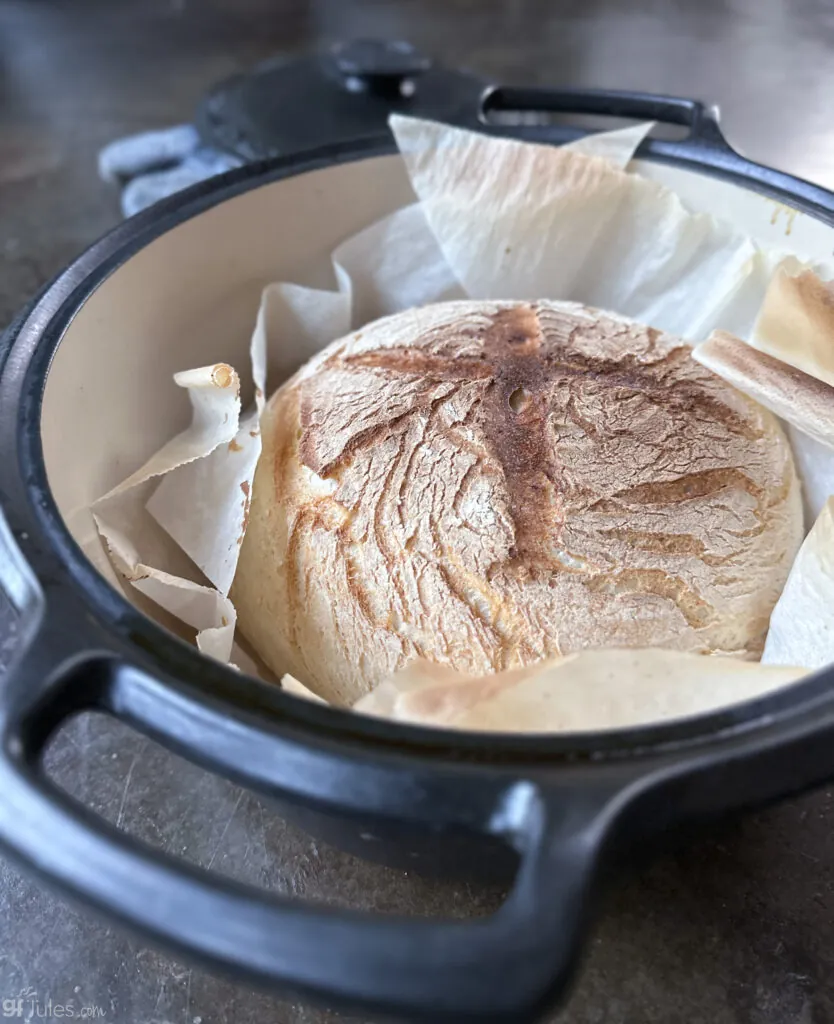
Gluten free sourdough made in an Emile Henry bread baker …
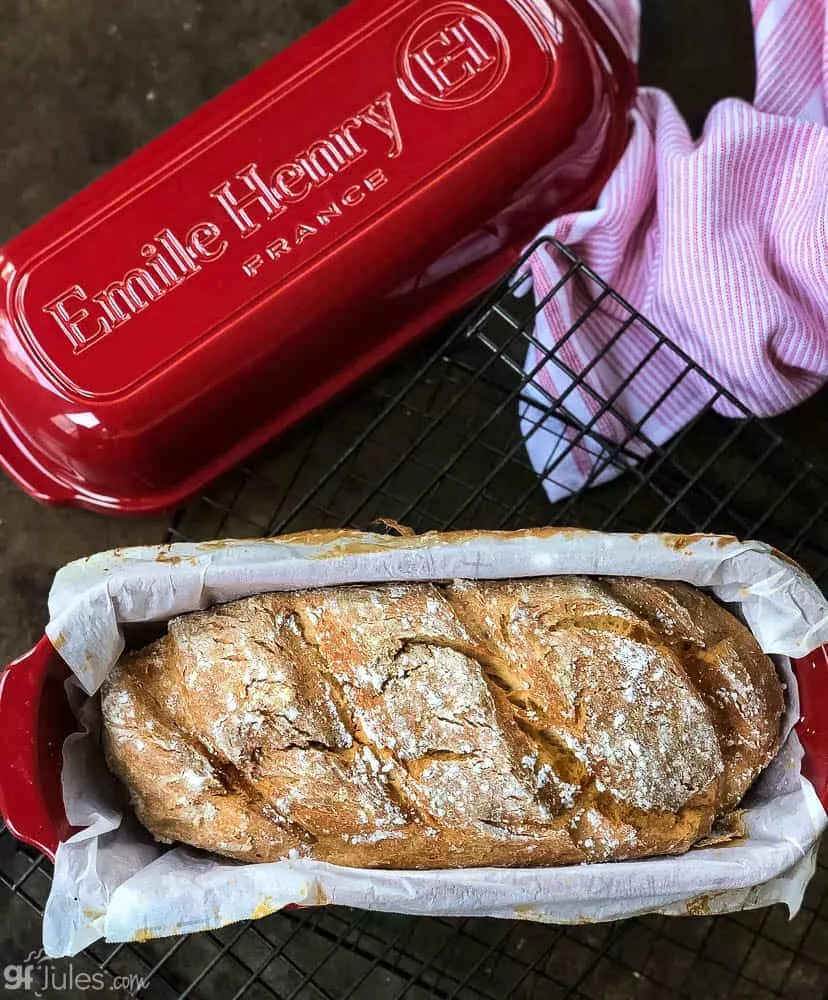
Gluten free sourdough baked in a Pullman Pan …
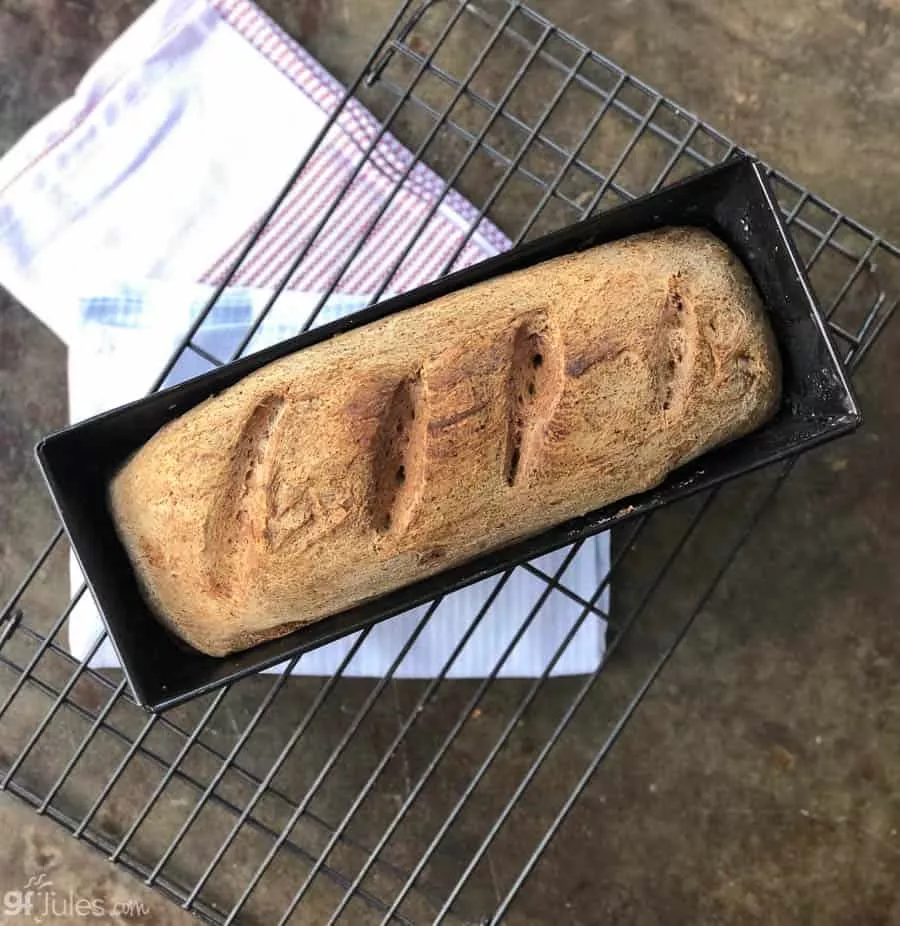
Gluten free sourdough baked as a boule without a pan …
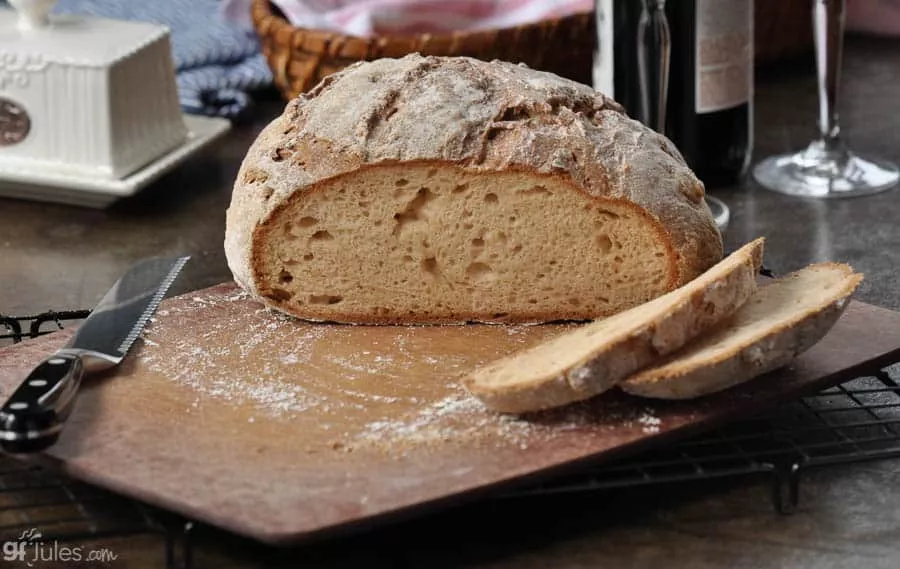
Gluten free sourdough baked on a baking steel and ultralight baking shell from Brod & Taylor. I’m loving this new-to-me method, by the way.
It’s similar to baking with a Dutch Oven, but the baking shell is so easy to handle and only weighs 1 pound 1 ounce! Comes in batard shape (shown here) or boule.
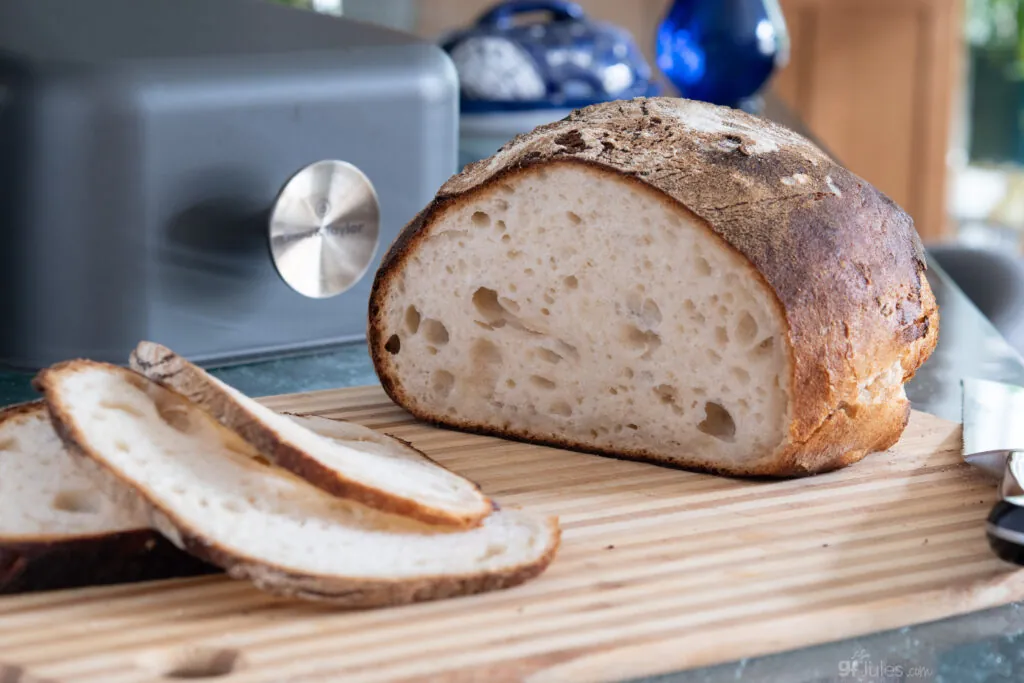
I’ve baked experiment after experiment, tweaking it here and there to account for lots of variables over the years, and I’m happy to share all my gluten free sourdough secrets and methods with you in this comprehensive post!
The creation of the first successful gluten free sourdough starter (click here for recipe) and gluten free sourdough bread recipe was a painstaking process, but at least we’ve enjoyed tons of gluten free sourdough along the way (leftover sourdough makes an insane overnight gluten free French Toast Casserole!).
I urge you to hang in there and read through my entire post, as I outline what has worked best and what has not worked best for me.
There are definitely some tricks of the trade, including how to get your gluten free sourdough to be sour!

Gluten Free Sourdough Basics
For those who love and miss sourdough, take heart! The art of making sourdough isn’t lost without the gluten. There’s still a lot of feeding, caring and waiting for the sourdough starter to mature and bloom into all its potential.
I’ve actually made so much starter that I’ve given much of it away to neighbors, but I just couldn’t throw any away when I’ve tended to it for so long! It’s like a little sourdough baby and you just can’t toss it out — I care about it! It’s “alive.”
Pro Tip: Use the search bar here at gfJules.com and search “sourdough” for lots of delicious gluten-free sourdough discard recipes so you don’t have to waste any of your precious discard either!
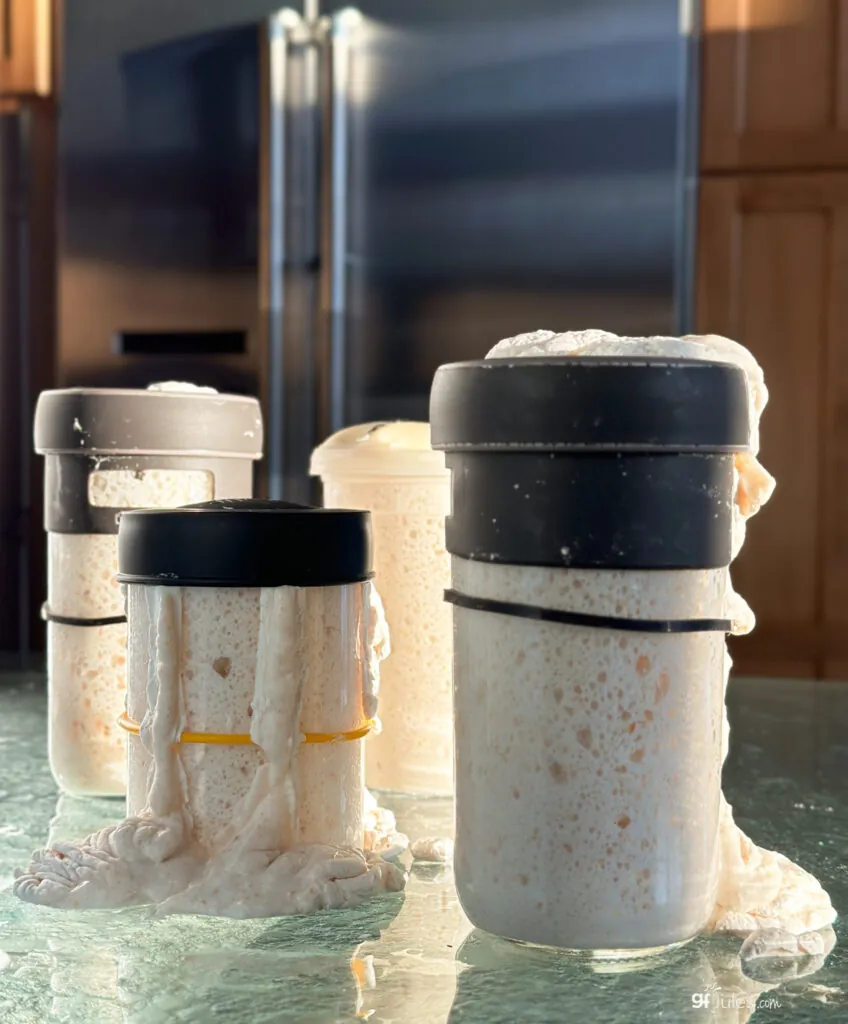
You’ll see when you make this gluten free sourdough starter; you’ll see. You won’t want to discard any of the “extra” either. It’s precious. Here’s how to make your very own gluten free sourdough starter!
Some things are the same about making gluten free sourdough bread as they are with making any other gluten free bread. There’s no kneading the bread and stretching the gluten because there’s no gluten! Just follow my instructions to the letter, use my gfJules Gluten Free All Purpose Flour or gfJules Multigrain Baking Flour and sit back to watch the magic happen.
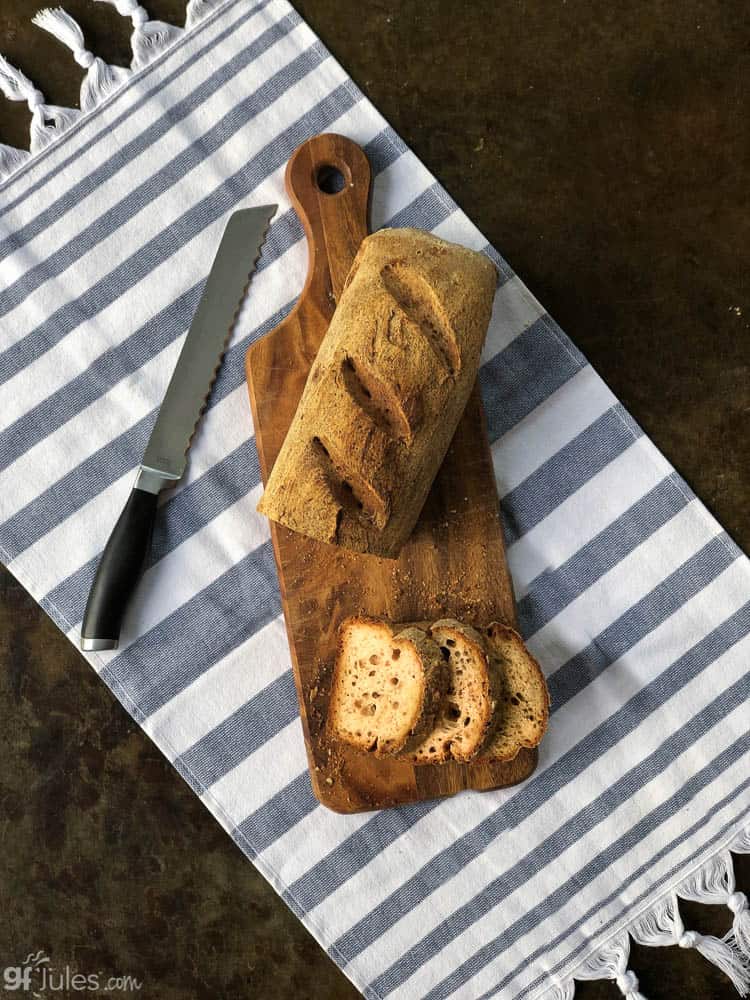
Choosing the Right Gluten Free Flours for Gluten Free Sourdough Bread
In anticipation of many questions to come, this recipe and process was developed using my gfJules Gluten Free All Purpose Flour because it works, I can rely on it every time, it’s easy, and it doesn’t taste funky or have any grit to it. If you try this recipe with another gluten free flour or blend, it really may not work, so please please please don’t even bother to try! But if you do, please don’t leave comments about how it didn’t work, because I’m telling you so before you waste your time.
Gluten free flours are tricky business. It took me two years to develop my original blend way back in 2003 (I’ve been gluten free since 1999!) and I’ve been tweaking and improving it ever since. Just because you think you can read ingredients and intuit how much of anything to use or to buy something off the shelf that sounds similar … you can’t. It won’t be the same, and the results won’t look like those pictured.
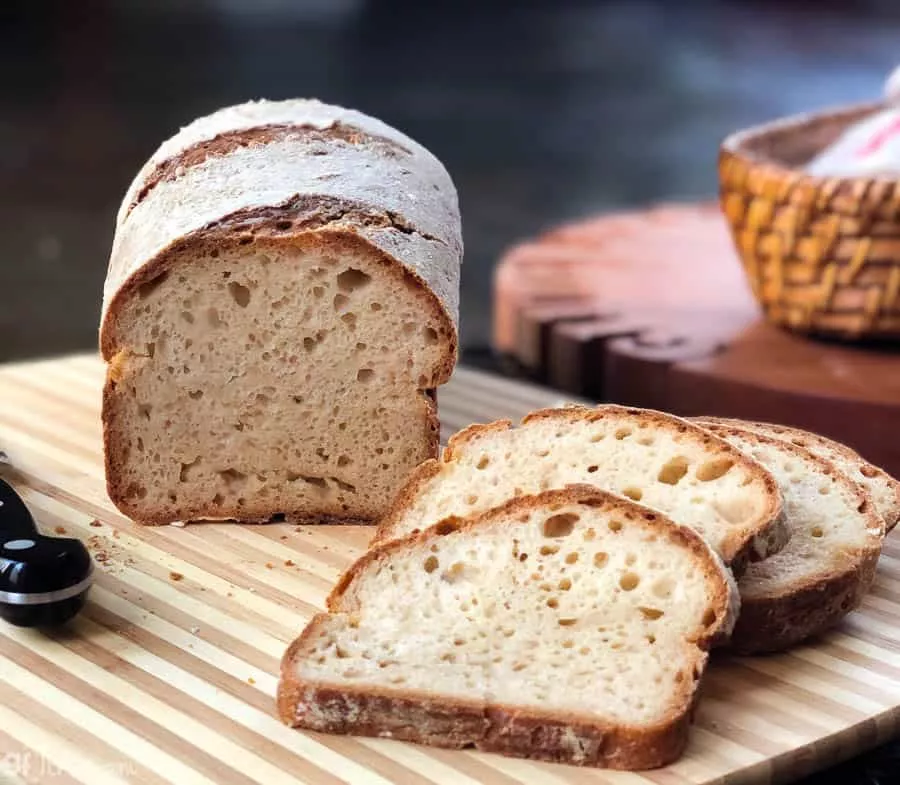
Not to belabor the issue, but tenths of a percentage point difference in proportions and a different brand or country of origin for any given ingredient are things that can make huge changes in outcomes. It amazes me all the time how tiny variances make big differences.
Which is why I developed my gfJules Flour to begin with. Selfishly, I didn’t want to have to make it in my kitchen every time I baked! And unselfishly, I wanted to prevent fellow gluten-free bakers (and newbies to gluten free baking) from having to mess around with mediocre flours only to achieve mediocre results.
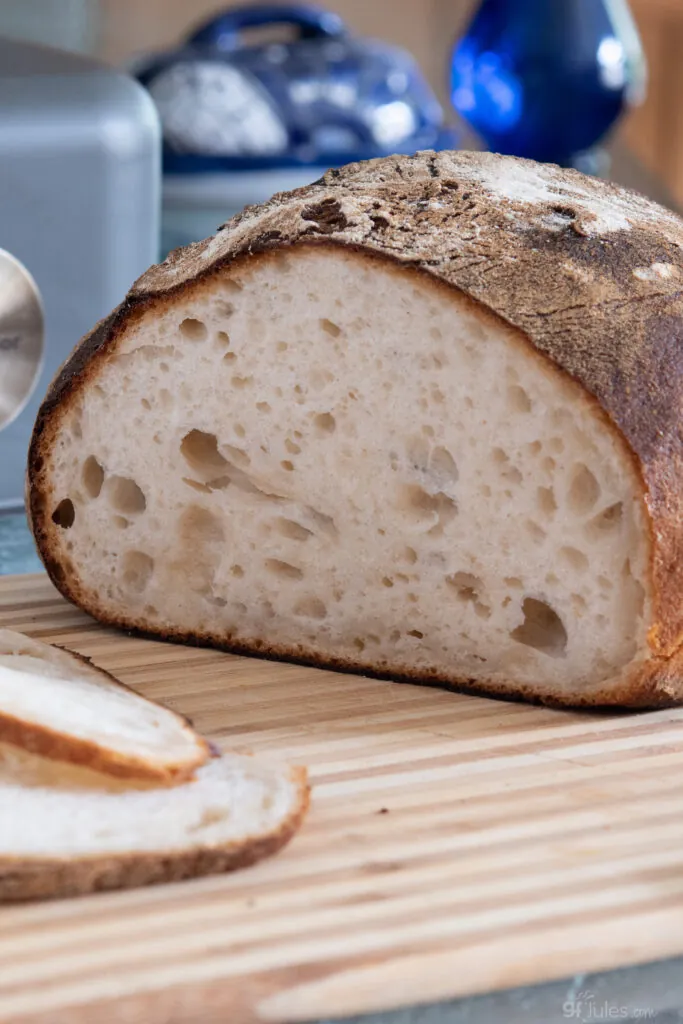
In the process of developing this gluten free sourdough recipe, I learned that my Gluten Free Multigrain Baking Flour is the PERFECT flour for sourdough starter. It goes crazy for it! So if you’re looking for the easiest way to get to gluten free sourdough nirvana, arm yourself with just two gluten free flour blends: gfJules Gluten Free All Purpose Flour and gfJules Gluten Free Multigrain Baking Flour. It’ll make your sourdough baking so much easier!
For more help with gluten free bread baking, in general, hop to my 18 Top Gluten Free Bread Baking Tips.
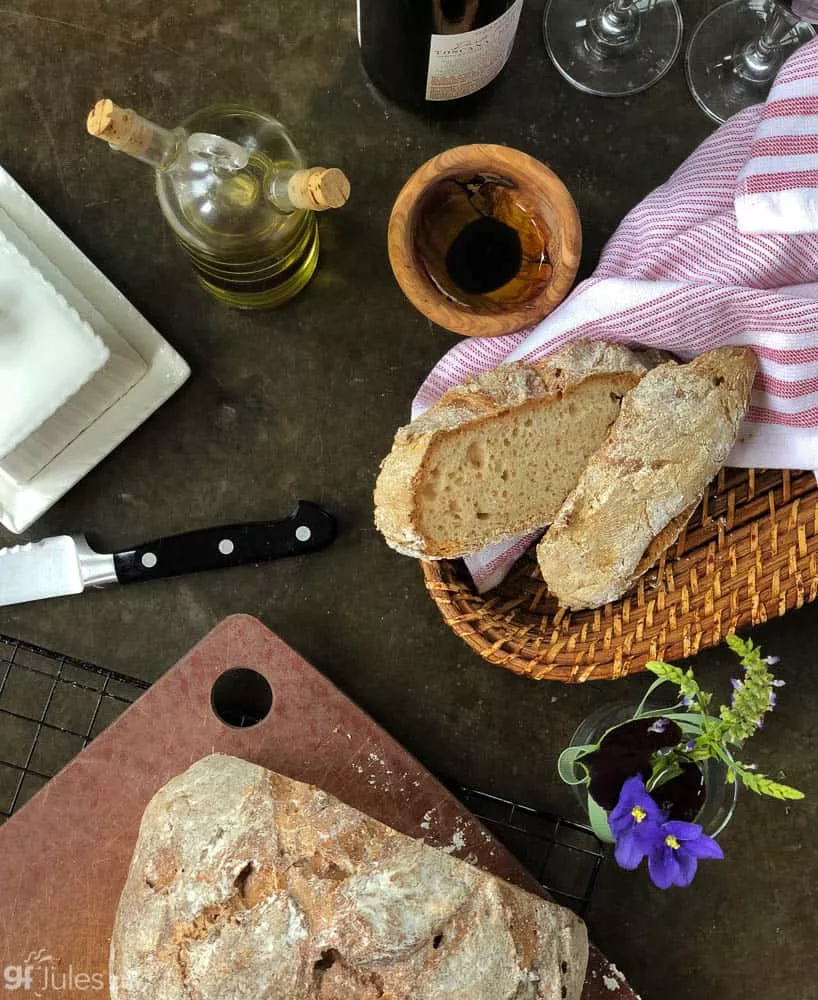
Baking Gluten Free Sourdough — Choosing the Right Pan
As you can see at the top of this post, there are many different options when it comes to baking your gluten free sourdough bread.
Follow along with one reader’s VIDEO of how she made her beautiful gluten free sourdough loaf using with this recipe and this artisan method following clicking here to watch!
Artisan Style Gluten Free Sourdough Bread Method
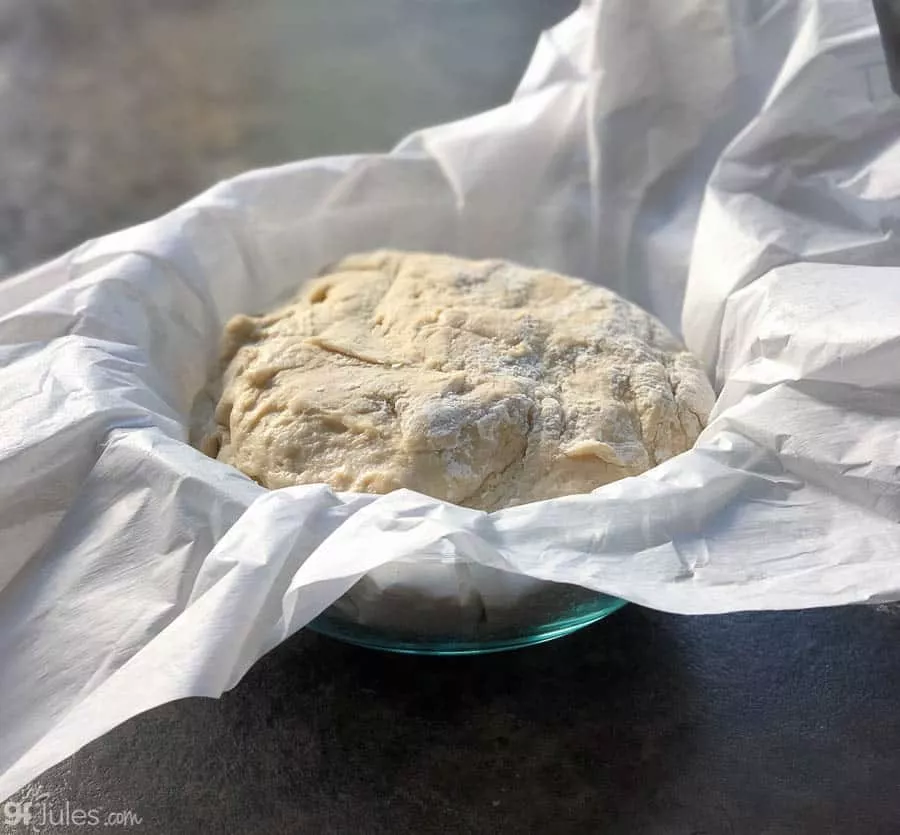
For an artisan-style boule, I prefer lining a banneton (proofing basket) or large glass bowl with oiled parchment sprinkled with more gfJules Flour to support the bread as it rises.
Once risen, I simply lift up on the parchment and lay it out onto a baking sheet for the bread to bake, or put it into a Dutch Oven, or slide onto a baking steel and cover with a baking shell.
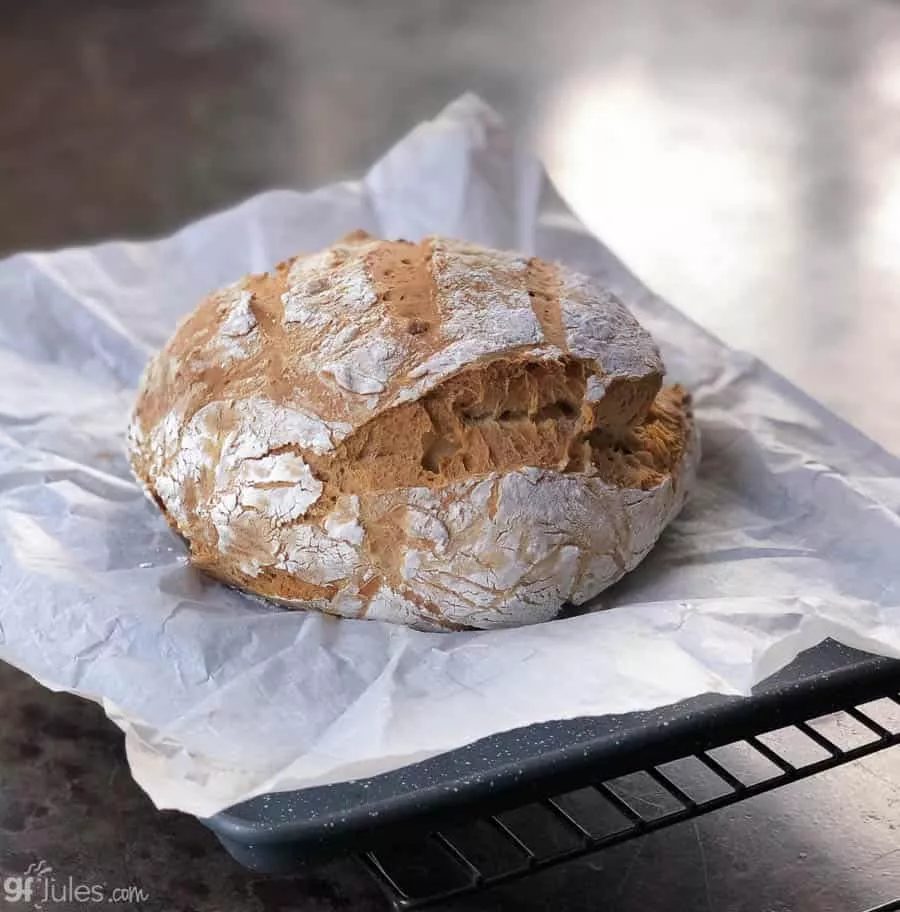
The bread will take more of a free-form shape, but it’s really beautiful and impressive!
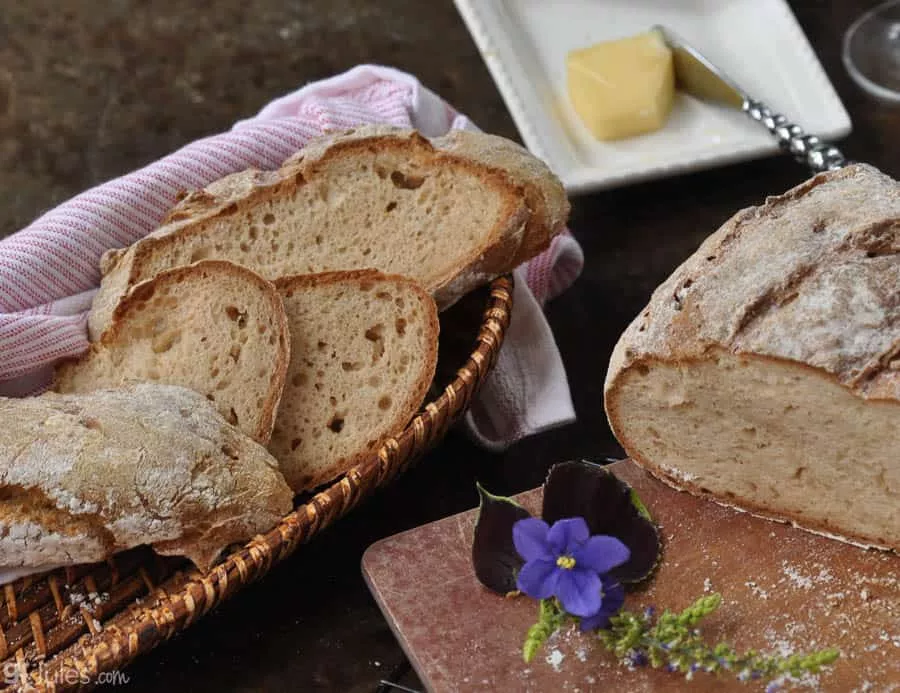
Using either the artisan or bread pan method, you may choose to dust the top of the loaf with gfJules Flour before baking for a more rustic look, or simply brush olive oil onto the top, or both.
Loaf Pan Gluten Free Sourdough Method
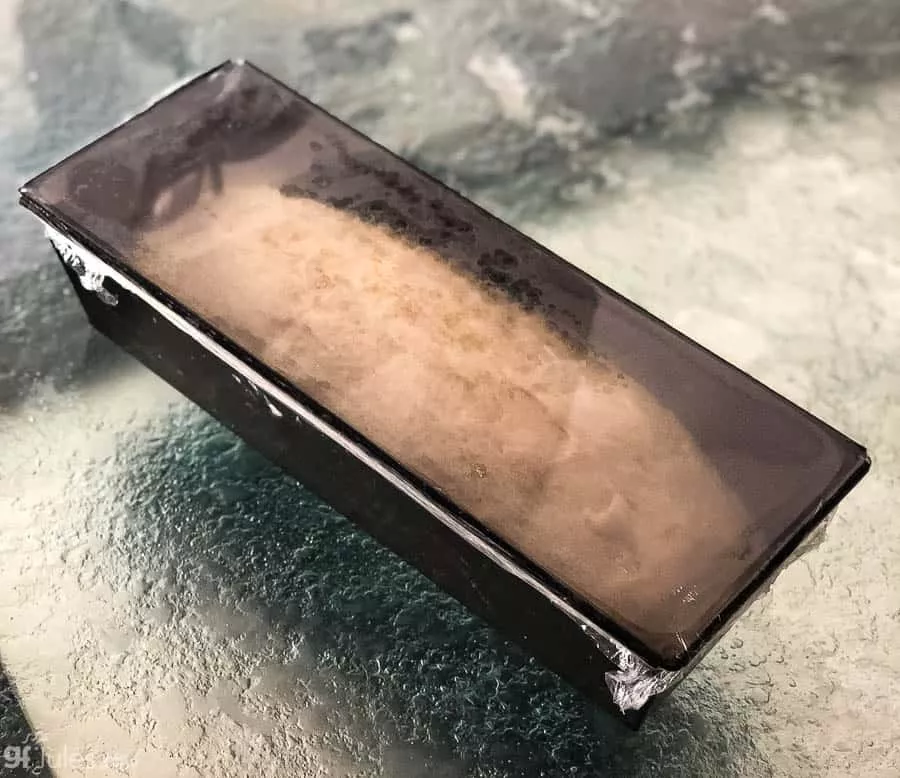
Place the dough into an oiled or parchment-lined pan and brush with oil. Allow the dough to rise covered with oiled plastic wrap to help keep the loaf warm and moist. I like putting the loaf into a preheated 200F oven, then turning the oven off, but turning the light on. I do this with the bread rising in either the bowl or the oiled and floured bread pan.
You can allow the bread to rise here for a minimum of 1 1/2 hours. I find around 2 hours is about right.
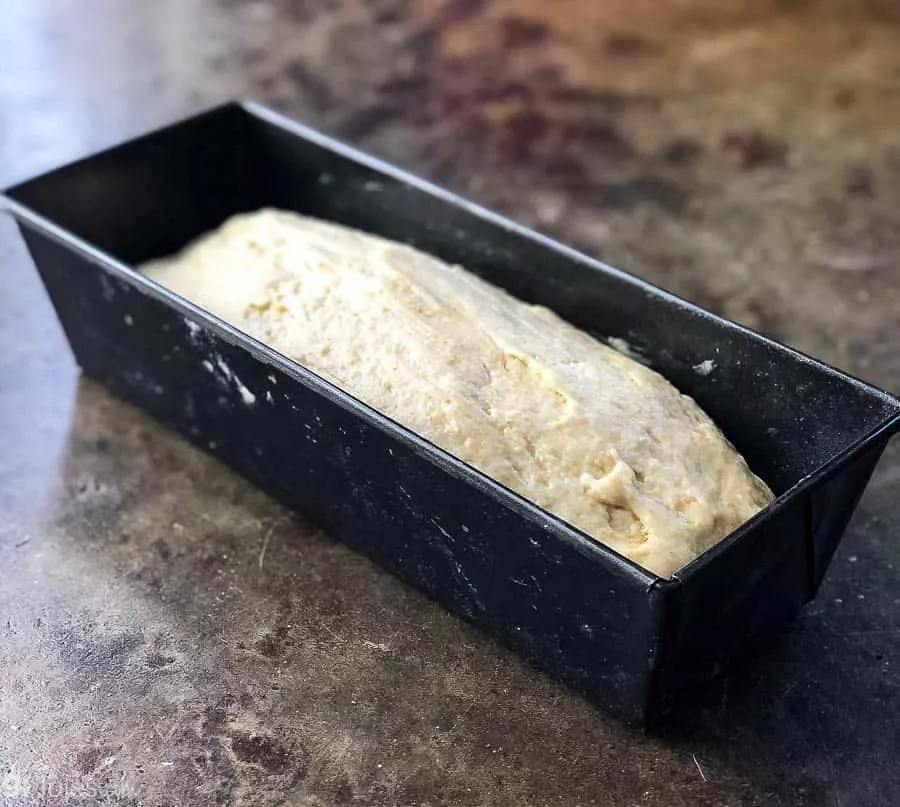
NOTE: The bread won’t have risen a lot, as most of the rising happens when it’s baking.
Feel free to oil and flour the bottom and sides of the pan or use lightly oiled and floured parchment for easier removal from the pan.
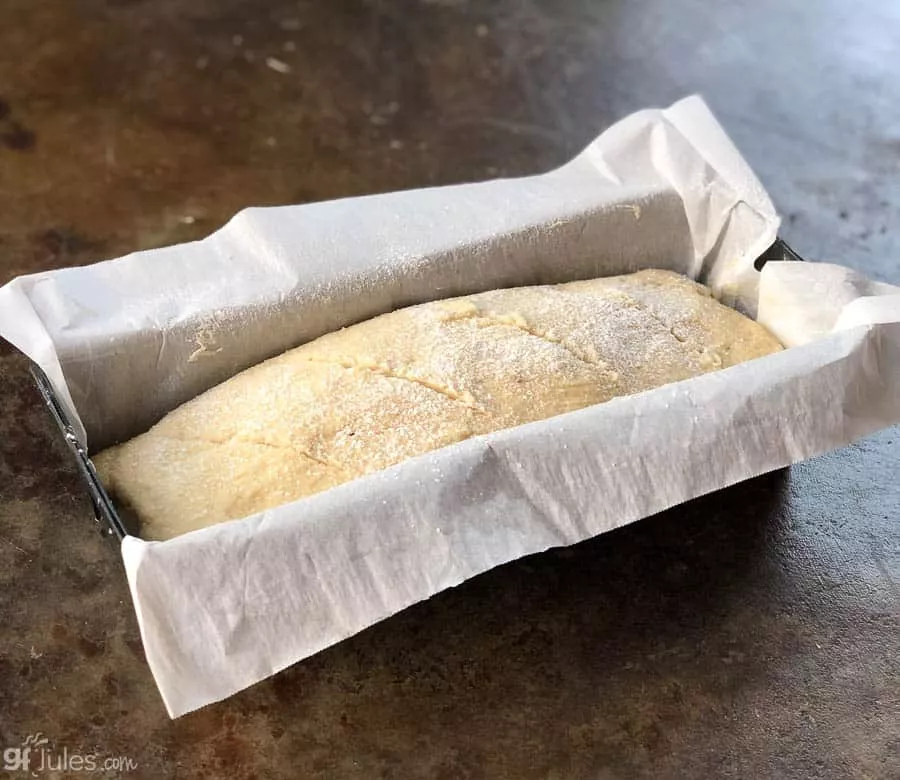
After rising, cut slits in the top of the loaf to direct the rise. Since the oil and/or the flour were applied before the slits were cut, the inside of the slits will appear different from the crust and it gives the sourdough the hand-made look it deserves.
Regarding bread pans, I experimented with all kinds and sizes. For loaves, I really like a Pullman Pan like I used in most of these photos, but a baker with a lid creates a Dutch oven effect which is great for the crust. The bread dough is a bit too voluminous for a traditional 9 x 5 (or smaller) bread pan; in those, this wet dough would rise high and then tended to collapse a bit, leaving some un-cooked looking areas in the center.
The Pullman Pan (mine is 12 x 4 1/2) seemed to be the perfect size to allow the bread to rise with support up the taller sides.
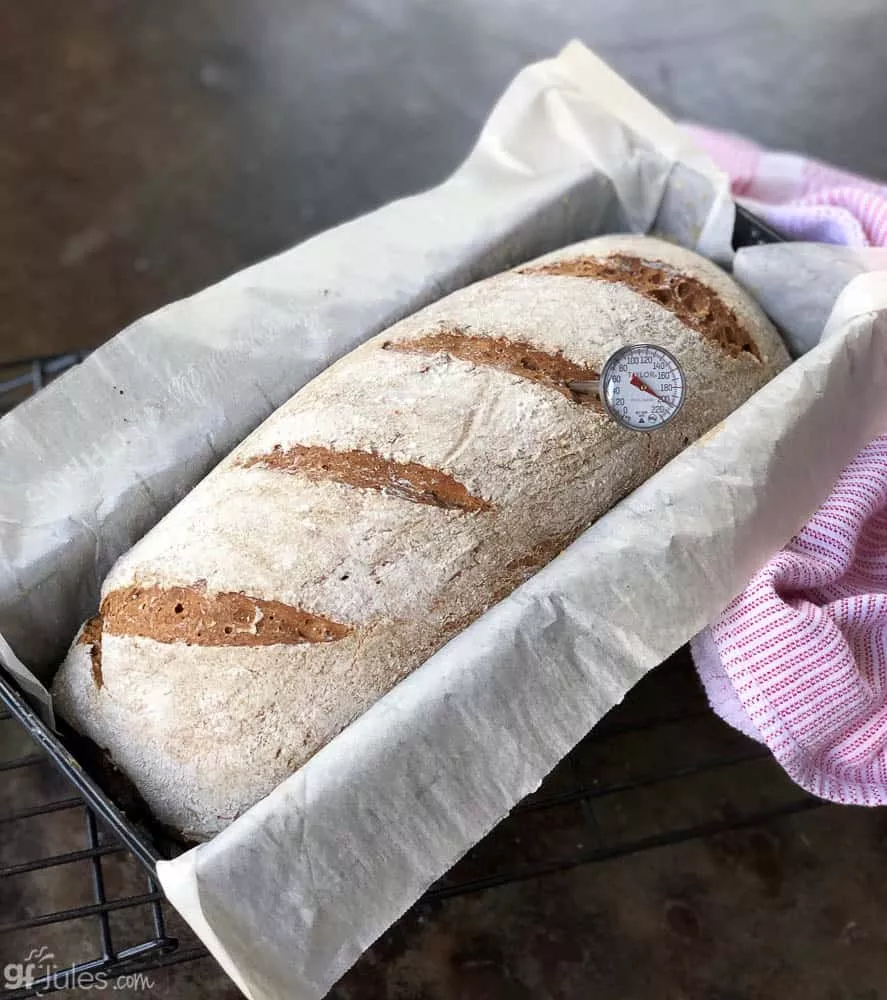
The time it takes to bake this bread will differ based upon the pan used and of course, on individual oven variations. I highly recommend buying an internal thermometer to take the bread’s temperature before removing it from the oven.
The internal temperature should be at least 205F before removing it from the oven to cool.
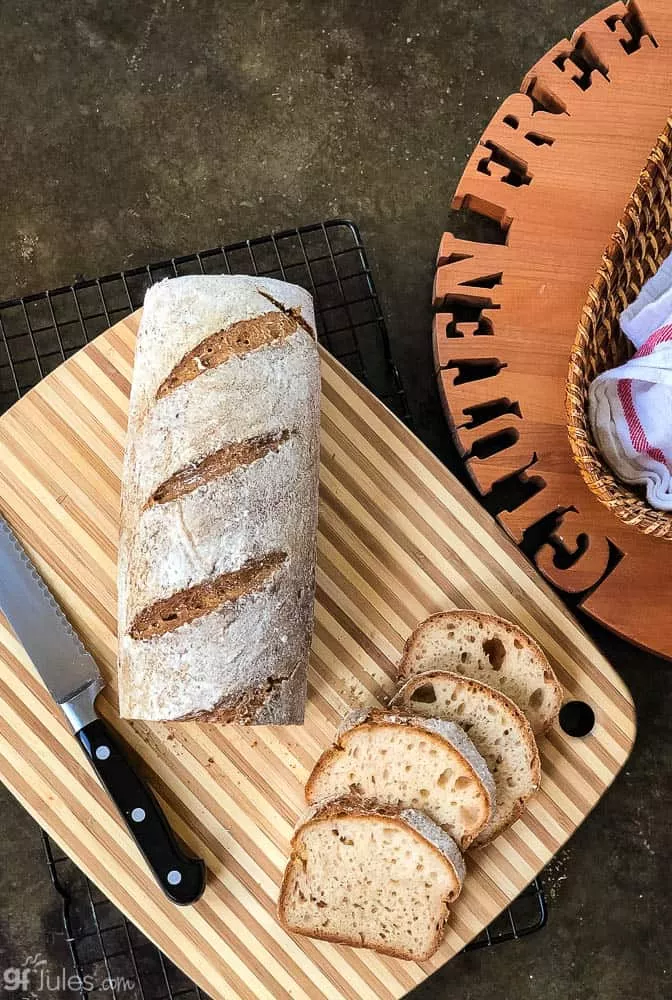
How to Make Gluten Free Sourdough Taste Sour
There are three main distinguishing features of sourdough: taste; smell; and texture. You might expect that the most difficult feature to achieve in gluten free sourdough would be texture, but as you can see from the photos, the artisan texture, open cell structure and crunchy crust are present in each of my loaves made with my gfJules Flour (plus psyllium husk) or my gfJules Bread Mix.
The smell is something that is quite noticeable from the starter. It should be tangy and rather sour smelling to know it’s really active. If your starter isn’t smelling very sour, it needs to age longer and/or be fed more.
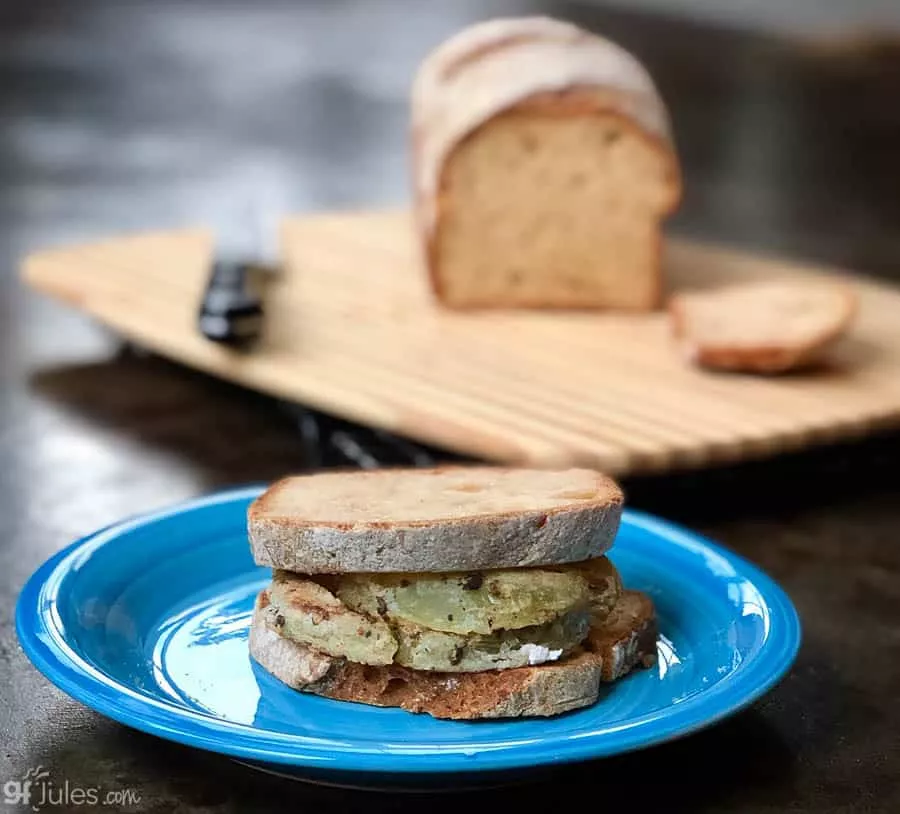
But the sour taste was the thing that seemed to be most elusive for me in my early bread experiments.
My first breads came out tasting yeasty and mild, just perfect for sandwiches or dipping in olive oil and balsamic (which we’ve been doing nearly every night for weeks now!).
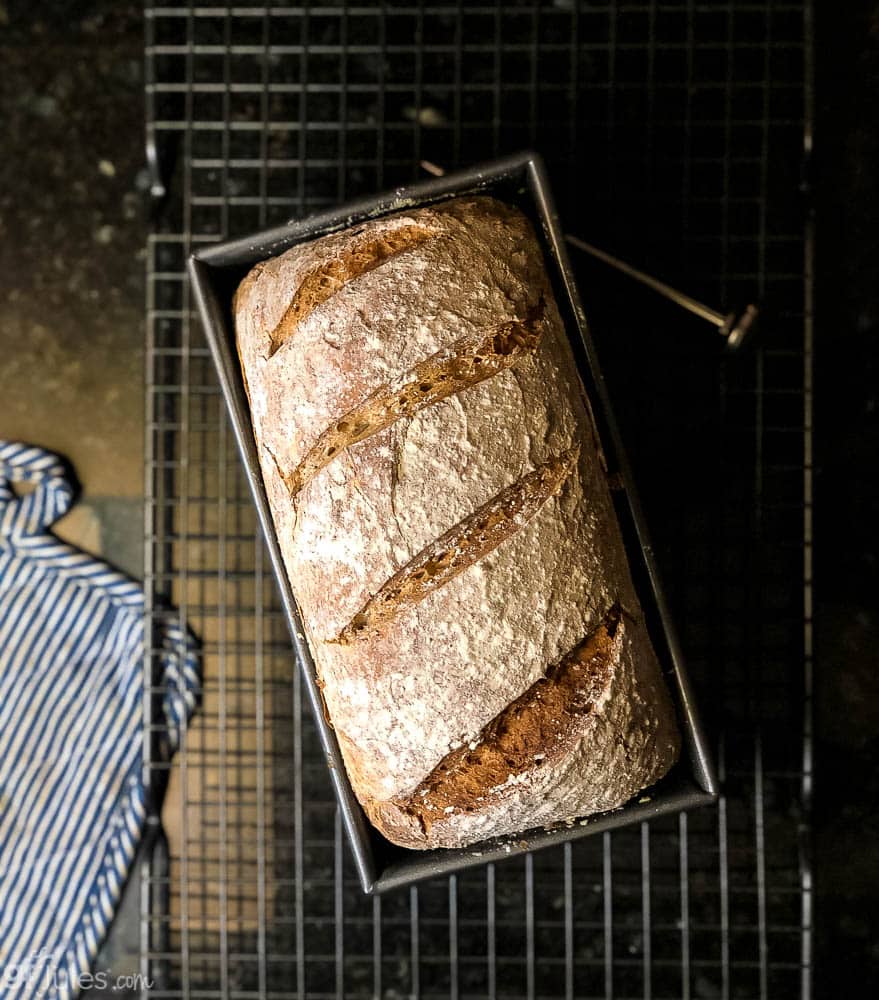
No, the sour taste didn’t come easily. I did achieve it somewhat when I allowed the bread to rise overnight, so if you are searching for that sour, I recommend budgeting time for an overnight rise. But I wanted MORE SOUR. Lucky for you, I cracked the code on that too.
How Do I Make Gluten-Free Sourdough Taste More Sour?
- Overnight Rise. I allowed my bread to rise as I described above, then placed it in the refrigerator overnight (still covered), then removed it the next day to sit on the counter to come to room temperature before baking. THEN the sour started to show through! (note: if you’re baking egg-free, leaving the dough covered in the oven turned off overnight is a good way to get that sour taste.)
- But even more revolutionary, I’ve recently changed my recipe to remove any chemical leaveners (baking powder, baking soda) which altered the pH and allowed the sour flavor to shine through. Those ingredients counteract the sour tang, so adding them negates the sour. This tweak has really made the difference in my gluten free loaves tasting more sour.
- Another site has recommended NOT feeding your sourdough starter again before baking with it in order to increase the sour flavor of the bread. This will also decrease the rise and will necessitate a longer proofing time, however. (Go here for the recipe to make your own gluten free sourdough starter)
- Add more apple cider vinegar. You can always add another tablespoon or two, and reduce the liquid in your recipe to compensate.
If you do any experimenting of your own and find other ways to make this bread taste sour-er, please share in the comments below!
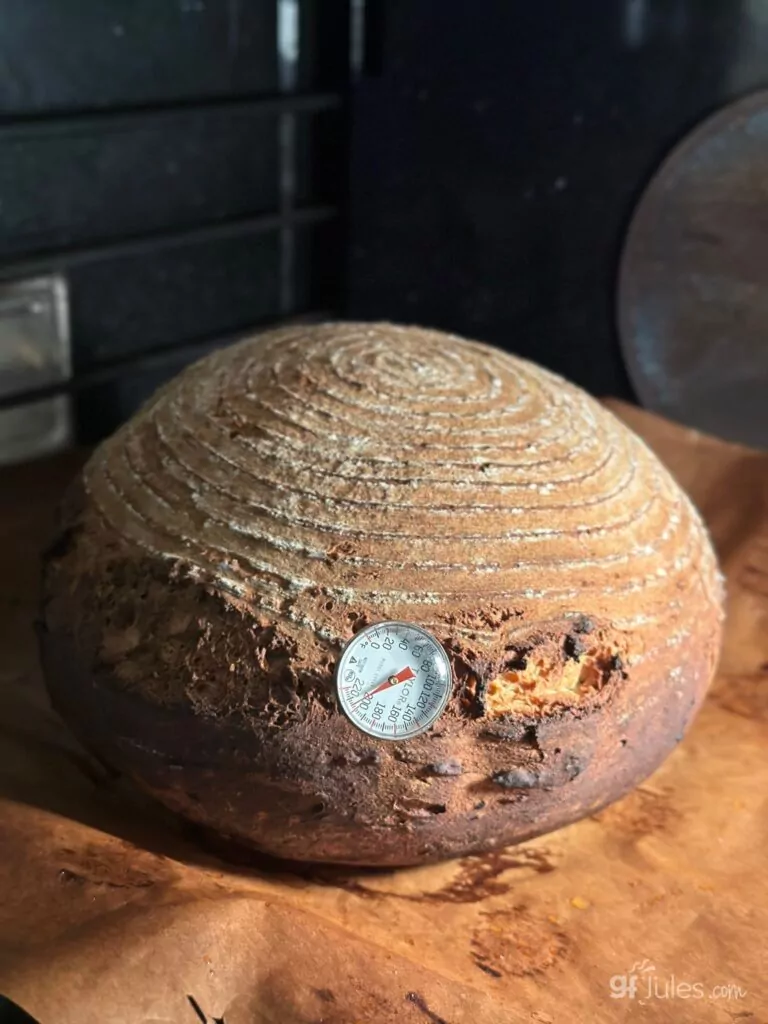
Storing Your Homemade Gluten Free Sourdough Bread
I always recommend storing your baked goods at room temperature in a sealed container, and this gluten free sourdough bread is no exception. The simple truth is that if you put baked goods into the refrigerator, they will dry out. You can put them into the freezer when they are fully cooled, but they will need to be warmed or toasted before enjoying again.
This gluten free sourdough bread is still soft and delicious after a few days in a zip top bag with the air squeezed out of it and stored at room temperature. Depending on the size of your loaf, you may need to cut it in half to get it to fit into a gallon sized bag, but other than that, it’s easy to just seal it up and grab a slice whenever you like! You can also store the bread European-style in a cloth or bread blanket.
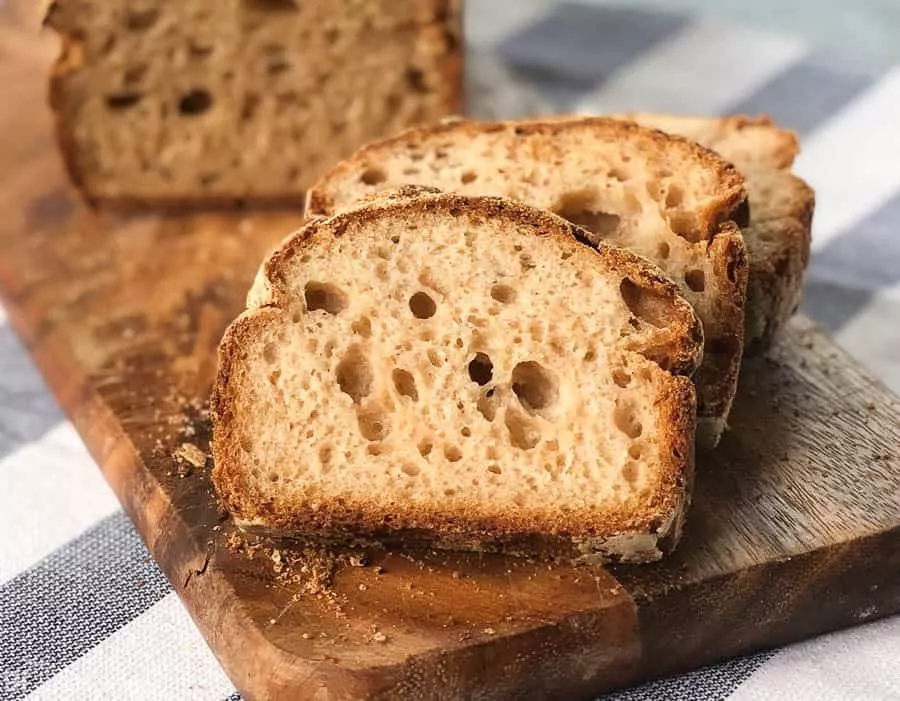
If you’d like to bake a regular gluten free artisan loaf without the sourdough starter, check out my Gluten Free Artisan Bread Recipe. And of course, my award-winning gfJules Gluten Free Bread Mix works well for any kind of sandwich bread, oven or bread machine, hamburger/hot dog bun or baguette recipe! Click on the “description” tab to find links to all these gluten free bread recipes or use the search bar above.
Also note that if you don’t have an aversion to using actual yeast, the best way to get a great rise AND the sourdough taste is to use a little yeast in your bread along with the sourdough starter. In France, in fact, it is permitted to add up to .2% active yeast to sourdoughs and still call the bread a naturally leavened sourdough. You’ll see I’ve recently added an option to add 1 teaspoon active dry or instant yeast to the dough if you’d like to try that method.
So let’s get down to baking great gluten free sourdough, shall we?
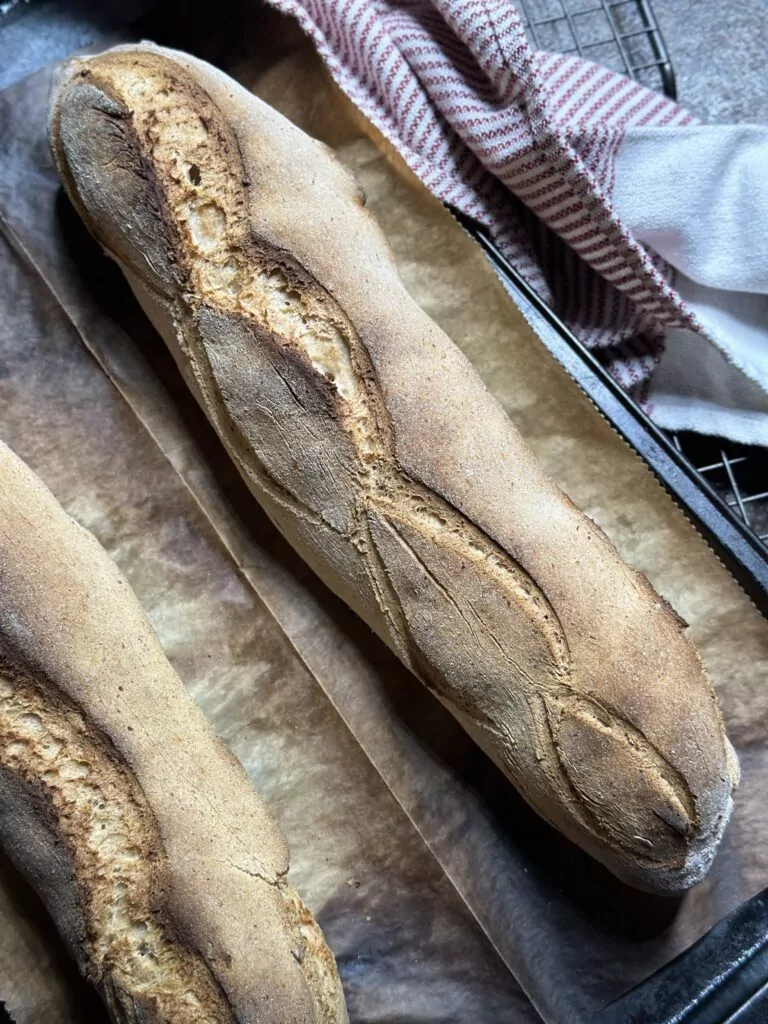
To make a homemade gluten free sourdough starter, hop to this recipe!
Note that this recipe is constantly evolving, the more loaves I bake, the more research I do, and the more feedback I get from you, my readers! What was great gets even better, so keep checking back in for updates to the recipe!

Gluten Free Sourdough Bread Recipe
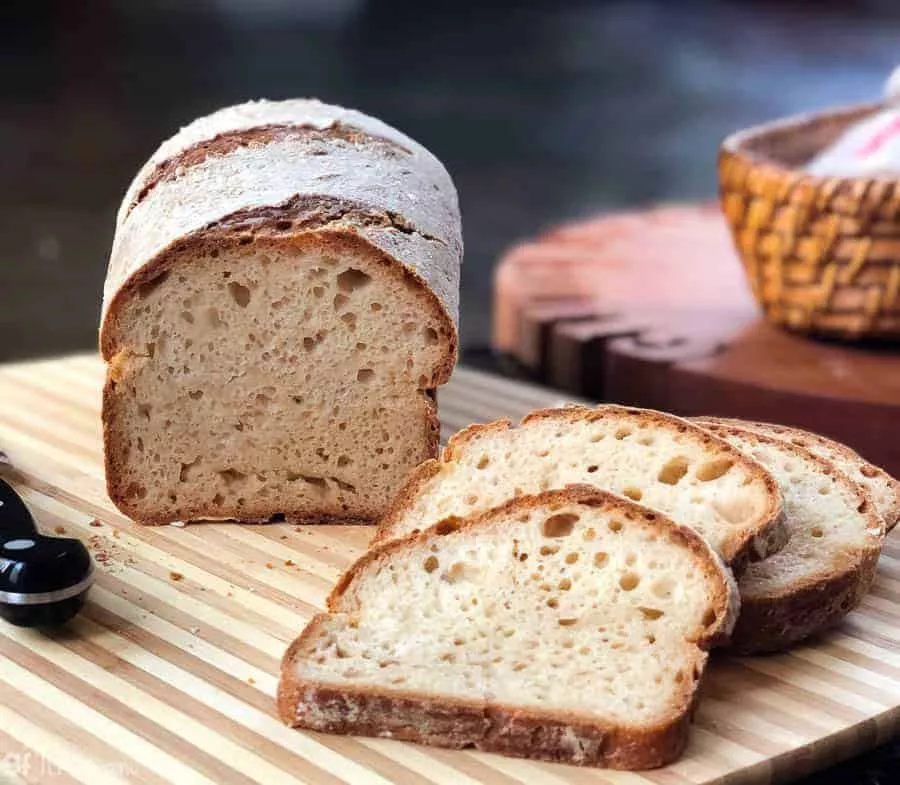
Gluten Free Sourdough Bread Recipe
Equipment
Ingredients
Sourdough Loaf or Artisan Bread Dry Ingredients
OR from scratch:
- 3 (420) cups (grams) gfJules® Gluten Free All Purpose Flour (for this recipe measure each cup to 140 grams/cup)
- 1/2 (70) cup (grams) gfJules Corn-Free Multigrain Flour (OR mixture of buckwheat flour OR cassava flour OR almond meal OR millet flour OR sorghum flour OR coconut milk powder)**
- 2 teaspoons kosher sea salt
- 1 teaspoon rapid rise yeast or active dry yeast like Red Star (this is OPTIONAL, but recommended if using young starter or less rise time)
PLUS These Other Ingredients
- 2 Tablespoons apple cider vinegar
- 1/4 (56) cup (grams) sugar
- 1 (11) Tablespoon (grams) psyllium husk powder (DO NOT ADD if using gfJules Bread Mix) optional with scratch recipe, but recommended (without psyllium, liquid may need to be reduced by 2-4 Tbs. if dough is too loose)
- 3/4 (185) cup (grams) active gluten free sourdough starter (feed 4-6 hours before)
- 1½ cup bubbly liquid like club soda, sparkling water, ginger ale OR naturally gluten free beer
Instructions
- Bring all ingredients to room temperature.
- Preheat oven to 200°F if rising there.
- Stir the following ingredients together in a large mixing bowl: apple cider vinegar, sugar, psyllium husk powder, and gluten-free sourdough starter. Mix until smooth and thickened, approximately 2 minutes. (If using gfJules Bread Mix, stir just until mixed, since you aren't adding psyllium.)
- In a separate bowl, whisk together remaining dry ingredients, then slowly add into the large mixing mixing bowl together with bubbly liquid. Use the paddle attachment on a stand mixer or a dough mixer hand tool. Mix until dough comes together. (If adding active dry yeast, proof yeast before adding.) Mix for two minutes with mixer, longer if by hand.
- Transfer dough to a clean counter or pastry mat dusted well with gfJules Flour. Turn dough several times in flour to smooth the dough and shape into a ball or a log for a loaf pan.
If Baking in Loaf Pan:
- Transfer dough to an oiled or parchment-lined Pullman Pan or 9x5 loaf pan, lightly dusted with gfJules Flour, or to floured parchment-lined pan or bowl for rising. Spritz with water, brush with olive oil, and dust the top of the dough with more gfJules Flour for best results.
- Cover with oiled plastic wrap and set inside oven warmed to 200℉. Turn oven off and turn light on.
- Allow the dough to rise for at least 1½ hours, or up to 3 hours before baking. Alternatively, after 3 hours, remove to refrigerator for further overnight rise. If refrigerating overnight, bring the dough to room temperature before baking the next day.
- Preheat oven to 350° F or 325° F convection.
- Remove plastic wrap and slice across the top of the dough as pictured to direct the rise.

- If you prefer a very crunchy crust, fill a spray bottle with water and spritz the dough again before baking, and again every 15-20 minutes while baking.
- Bake loaf in the pan for 75 minutes and test with a bread thermometer. The internal temperature should reach at least 205° F before removing to cool. If the bread is browning too much, cover with foil in order to keep baking.
- Once bread is fully cooked, remove to cool on a wire rack for 15 minutes before removing from the pan. Allow to fully cool before slicing.

If Baking Artisan Bread:
- Transfer to a proofing basket or oiled parchment-lined glass bowl.
- Cover loosely with a warm, damp tea towel or oiled cling wrap and place in a warm spot to rise for 1 - 3 hours before baking. Alternatively, after rising, remove to refrigerator for further overnight rise. If refrigerating overnight, bring the dough to room temperature before baking the next day.
- Invert gently onto a parchment lined baking sheet and remove basket or bowl. Cut a slice across the top at an angle with a lame or sharp knife before baking.

If Baking in Dutch Oven or Using Baking Shell:
- Place Dutch Oven inside oven and preheat oven to 500°F. If using a baking steel and shell method, place the baking steel on the oven rack to preheat (no need to preheat the baking shell).Once the Dutch Oven is preheated, remove lid and place parchment with dough boule inside, spritz with water, then replace the lid and put the Dutch Oven back inside the oven. If using baking shell, transfer loaf onto parchment and slide onto hot steel in the oven (using a dough or pizza peel helps here) then cover with baking steel.Bake for 20 minutes covered, then remove the lid and reduce the oven temperature to 450°F and bake for 25 more minutes. *To prevent the bottom of the loaf from burning, place an oven safe pan at least the diameter of your Dutch Oven or steel on the rack just below and fill with ice cubes. This will provide both steam and a buffer between the heating element and the bottom of the pan.*

If Baking On Baking Sheet:
- If baking without pan, place bread on parchment lined pan in 500°F preheated oven, then immediately reduce the temperature to 450°F and bake for 35 minutes, test internal temp and continue to bake if needed -- bake until bread is browned and internal temperature reaches at least 205°F. *To prevent the bottom of the loaf from burning, place an oven safe pan at least the diameter of your bread on the rack just below your baking pan and fill with ice cubes. This will provide both steam and a buffer between the heating element and the bottom of the pan.*

- Using either method, once the bread is baked, turn the oven off but leave the bread inside the oven with the oven door cracked for another 20 minutes before removing. Allow to fully cool before slicing to prevent any gumminess.
Video
Notes
- 56 grams sugar
- 2 Tbs. apple cider vinegar
- 3/4 cup active sourdough starter (fed ~6 hours earlier)
- 1 1/4 cup warm water
** Please keep in mind that nutrition information provided is per serving, which may vary. While we have taken care to provide you with the most accurate nutritional values possible, please note that this information may differ significantly depending on the exact ingredients and brands that you choose to use to make this recipe. Additionally, where options are given for ingredients, the resulting calculation may include all ingredient options instead of only one per line, skewing the totals significantly.
Recommended Products
Any links to Amazon may earn me a small amount from qualifying affiliate purchases; this amount goes to fund this blog and does not cost you anything additional.

Viva Naturals

Bragg Live Food Organic Apple Cider Vinegar 946ml/32fl oz

Regency Wraps RW450N, 9 Sq. ft, Natural

gfJules All Purpose Gluten Free Flour

Norpro NOR-3952 12" Bread PAN, Non-Stick, 12 inch

Empty Amber Glass Spray Bottles with Labels (2 Pack) - 16oz Refillable Container for Essential Oils, Cleaning Products, or Aromatherapy - Durable Black Trigger Sprayer w/Mist and Stream Settings

gfJules Gluten Free Sandwich Bread Mix
Can I Make GRAIN Free Sourdough?
I’ve been getting this question a lot lately. Grain-free blends are very different from gluten free flour blends, and they behave differently in yeast breads. BUT … I have developed a mostly GRAIN-FREE Sourdough variation that is quite lovely with my gfJules Nada Flour.
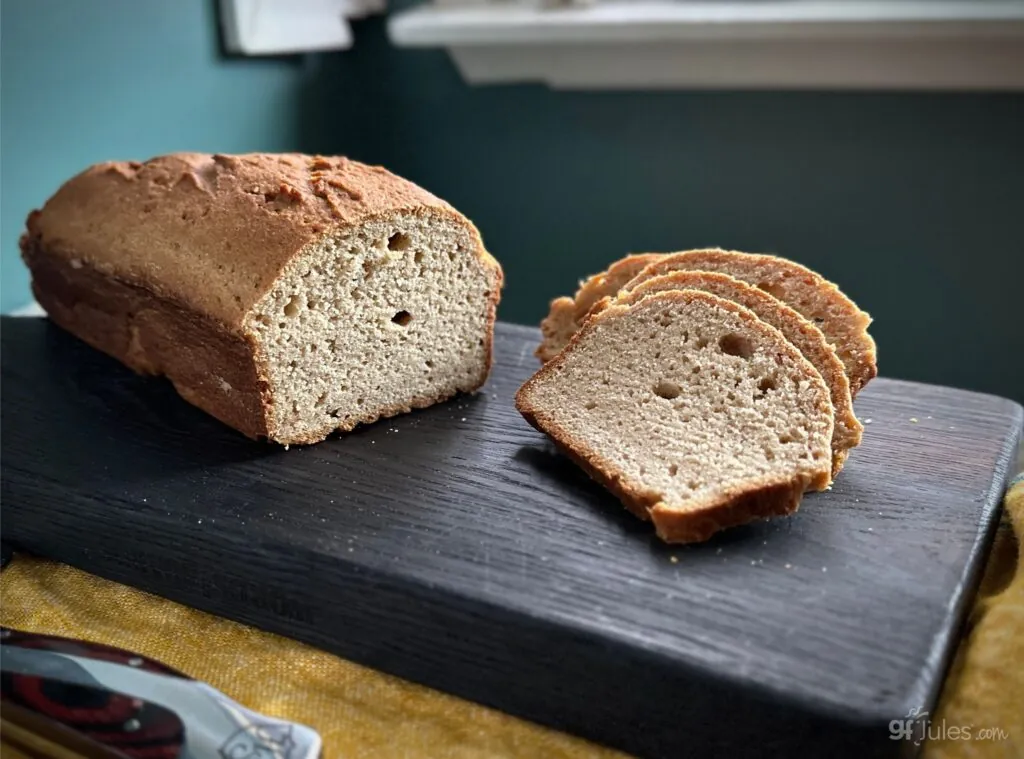
Of note: the starter I used was based on my gfJules Multigrain Flour, so it does contain grains, thus, this loaf is not entirely grain-free.
I have not yet had time to develop a grain-free starter. Alas, I am but one baker. Someday ….
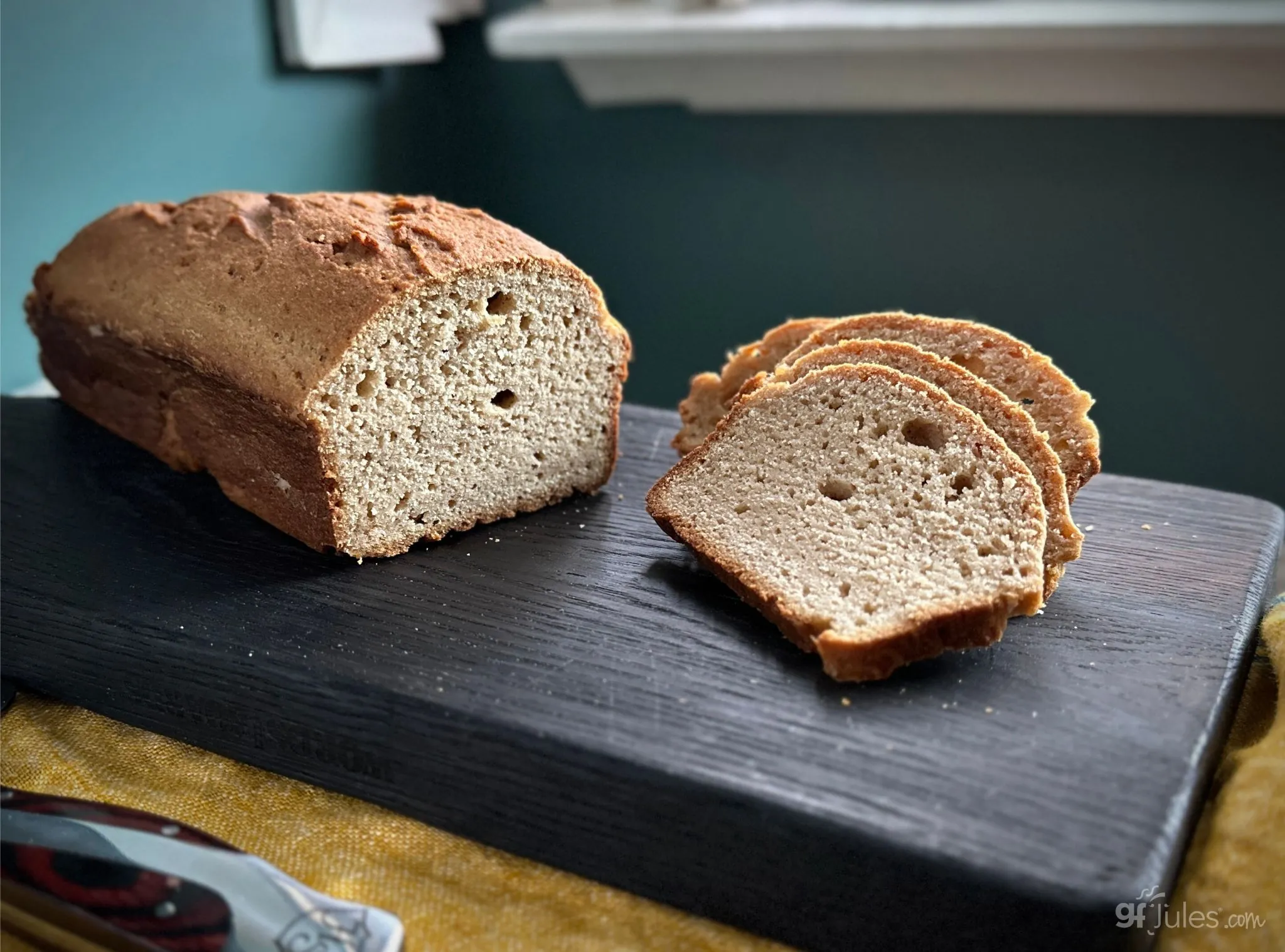
Mostly GRAIN Free Sourdough Bread Recipe
Ingredients
Sourdough Loaf or Artisan Bread Dry Ingredients
PLUS These Other Ingredients
- 2 large eggs OR 2 Tbs. flaxseed meal steeped 10 minutes in 6 Tbs. warm water
- 2 Tbs. apple cider vinegar
- 1/4 cup olive oil
- 1/4 cup 56 grams sugar
- 1 cup gluten free sourdough starter
- 1 cup club soda sparkling water, ginger ale, 7-Up, naturally gluten free beer, OR still water
Instructions
- Bring all ingredients to room temperature.
- Preheat oven to 200°F.
- Beat the following ingredients together in a large mixing bowl: eggs (or substitute), apple cider vinegar, oil, sugar, and gluten free sourdough starter. Mix until smooth.
- Slowly stir in dry ingredients with liquid, beating with paddle attachment on a stand mixer or using a wooden spoon until the batter is smooth and all dry ingredients are completely integrated. Mix for two minutes with mixer, longer with spoon method.
If Baking in Loaf Pan:
- Transfer dough to an oiled Pullman Pan or 9x5 loaf pan, lightly dusted with gfJules Nada Flour. Dust the top of the dough with more gfJules Nada Flour.
- Spritz with water and cover with oiled plastic wrap and set inside oven. Turn oven off and turn light on.
- Allow the dough to rise for at least 1 1/2 hours, or up to 3 hours before baking. Alternatively, after 3 hours, remove to refrigerator for further overnight rise. If refrigerating overnight, bring the dough to room temperature before baking the next day.
- Preheat oven to 425° F.
- Remove plastic wrap and slice across the top of the dough to direct the rise.
- If you prefer a very crunchy crust, fill a spray bottle with water and spritz the dough before baking, and again every 15-20 minutes while baking.
- Place uncovered loaf pan in oven, then reduce temp to 350° F. Bake loaf in the pan for 75 minutes before testing with a bread thermometer. The internal temperature should reach at least 205° F before removing to cool. If the bread is browning too much, cover with foil in order to keep baking. Bake for full 75 minutes, even if bread has reached internal temp earlier.
- Once bread is fully cooked, remove to cool on a wire rack for 15 minutes before removing from the pan. Allow to fully cool before slicing.
** Please keep in mind that nutrition information provided is per serving, which may vary. While we have taken care to provide you with the most accurate nutritional values possible, please note that this information may differ significantly depending on the exact ingredients and brands that you choose to use to make this recipe. Additionally, where options are given for ingredients, the resulting calculation may include all ingredient options instead of only one per line, skewing the totals significantly.
Recommended Products
Any links to Amazon may earn me a small amount from qualifying affiliate purchases; this amount goes to fund this blog and does not cost you anything additional.

Viva Naturals

Bragg Live Food Organic Apple Cider Vinegar 946ml/32fl oz

Regency Wraps RW450N, 9 Sq. ft, Natural

gfJules All Purpose Gluten Free Flour

Norpro NOR-3952 12" Bread PAN, Non-Stick, 12 inch

Empty Amber Glass Spray Bottles with Labels (2 Pack) - 16oz Refillable Container for Essential Oils, Cleaning Products, or Aromatherapy - Durable Black Trigger Sprayer w/Mist and Stream Settings

gfJules Gluten Free Sandwich Bread Mix
Many thanks to the indomitable Chef Patrick Auger for his help in developing this original recipe years ago. His passion for baking allergen-friendly foods has helped many a baker achieve amazing gluten free results like these!
I can’t wait to hear about your gluten free sourdough bread baking!
Pin for later!
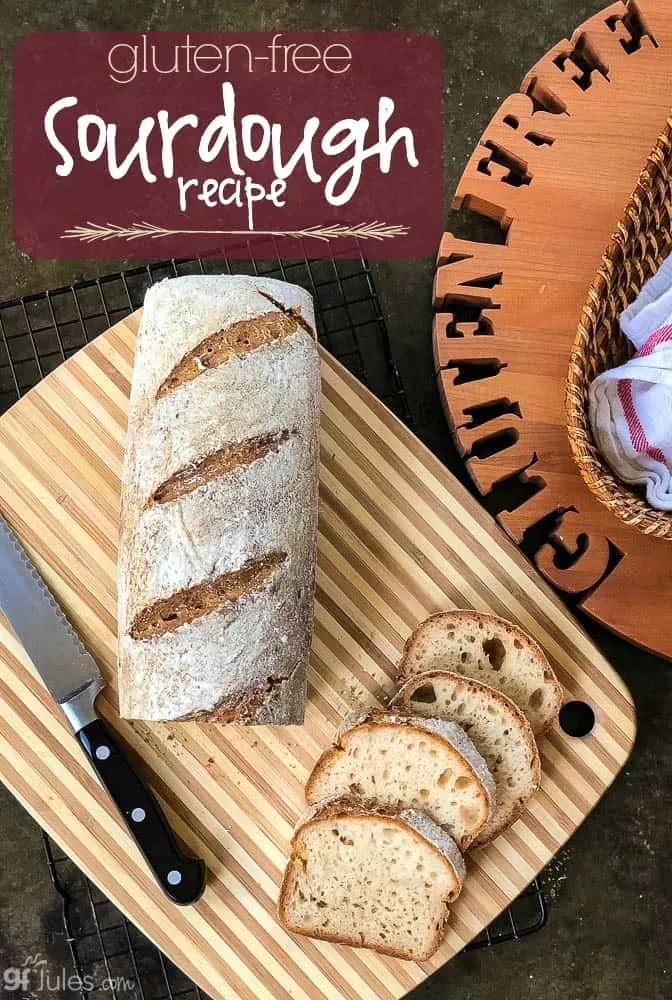
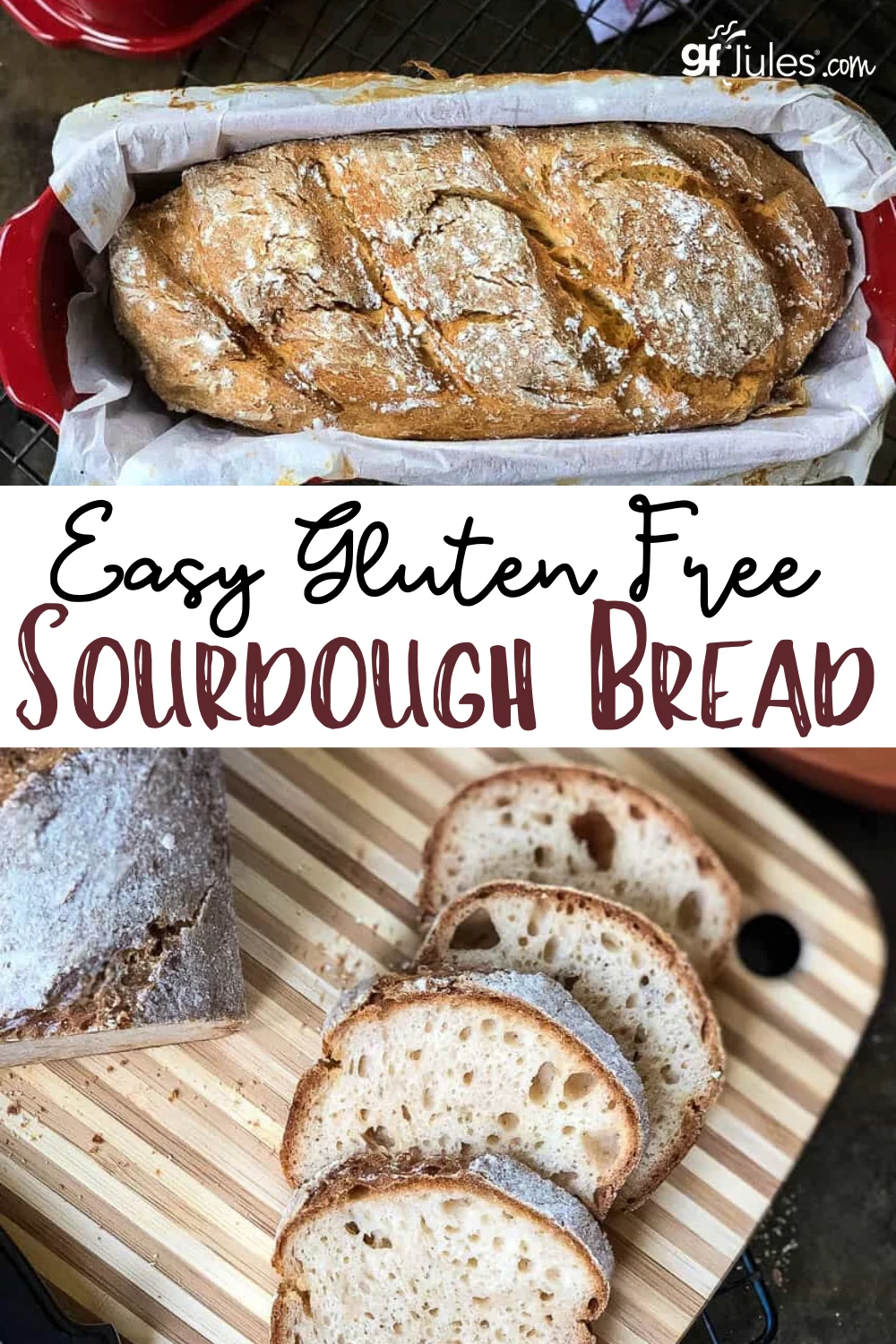
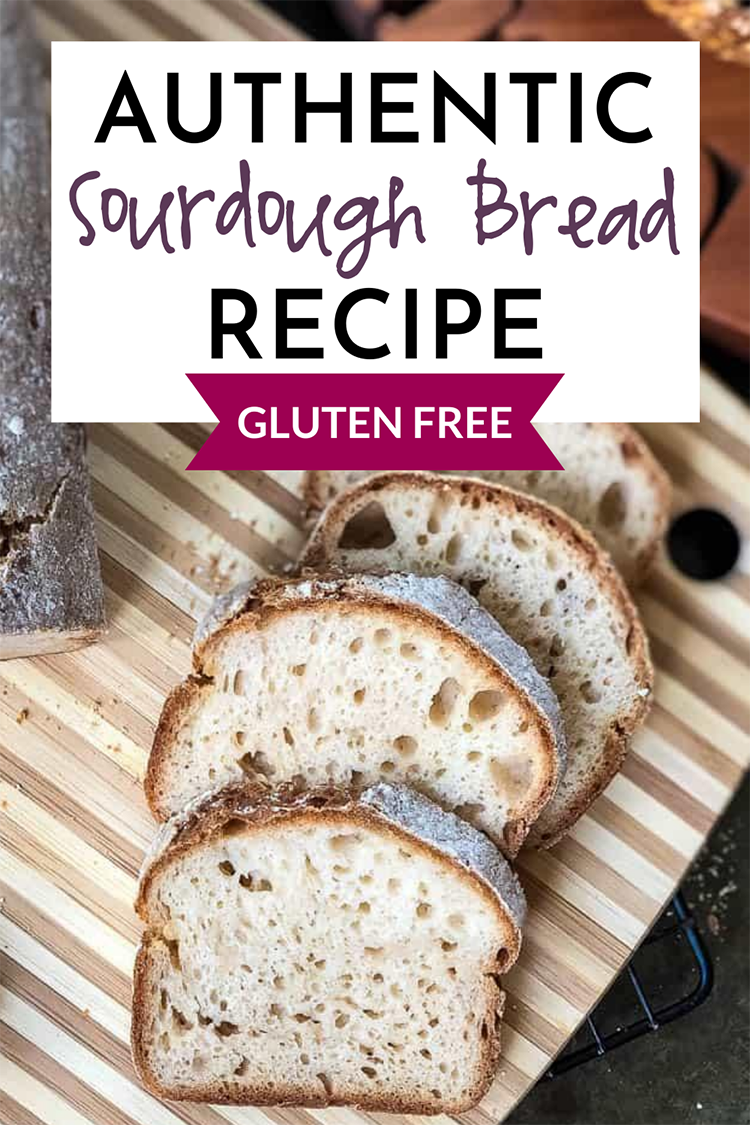
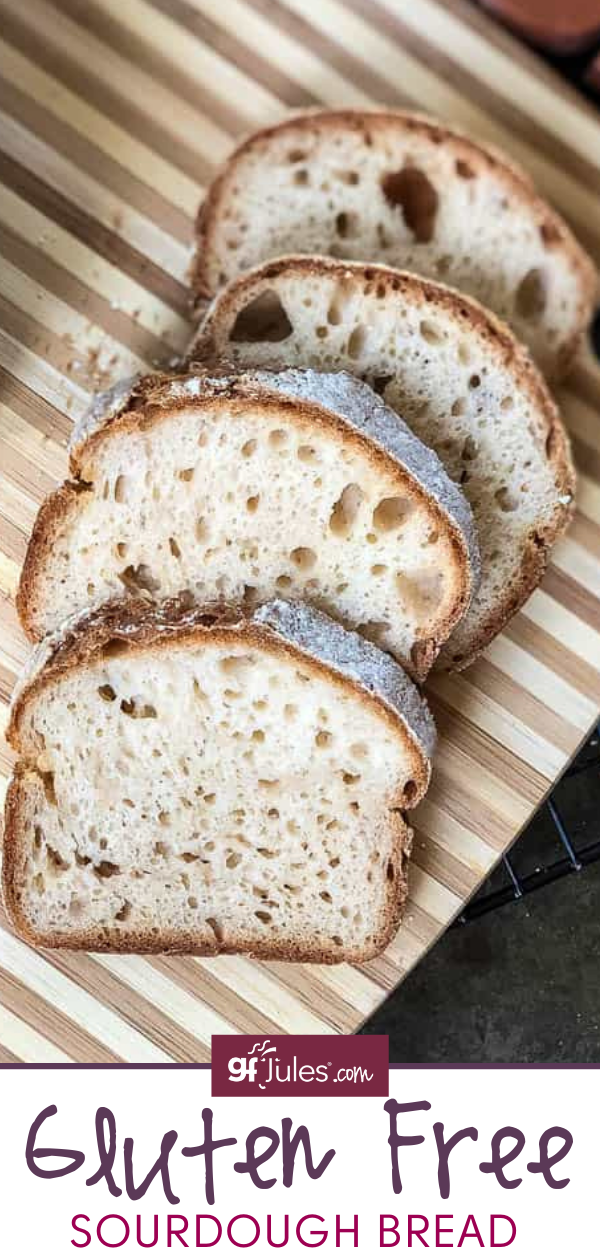





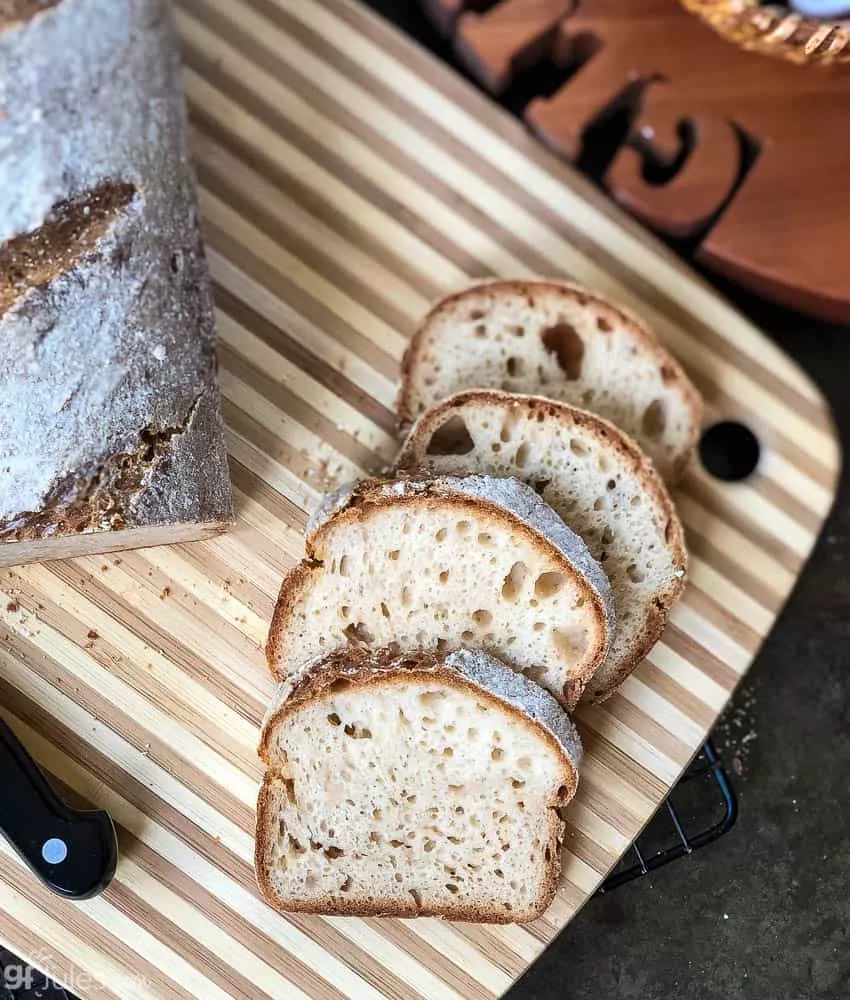
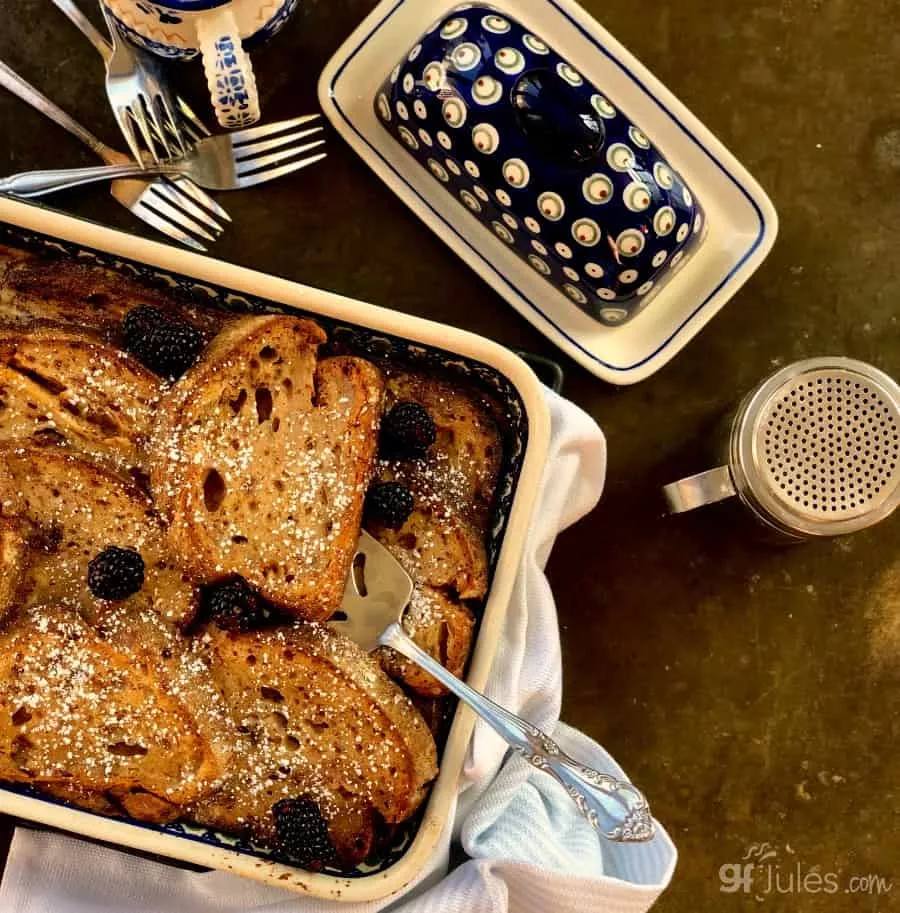
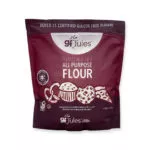
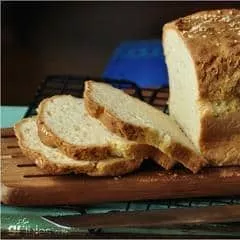
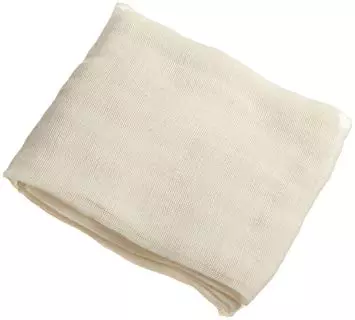



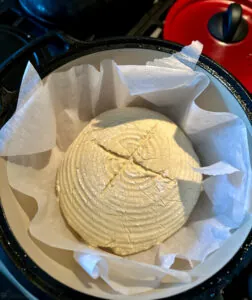

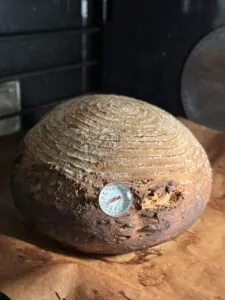
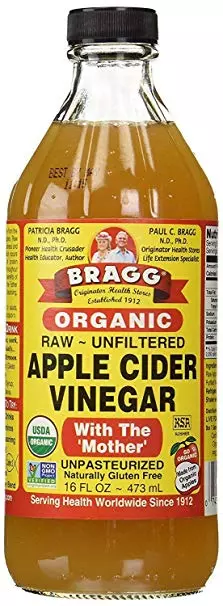
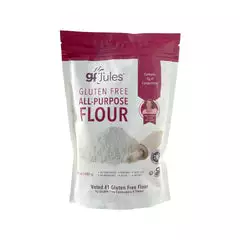











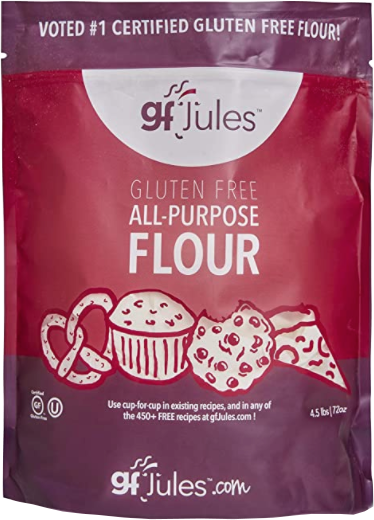
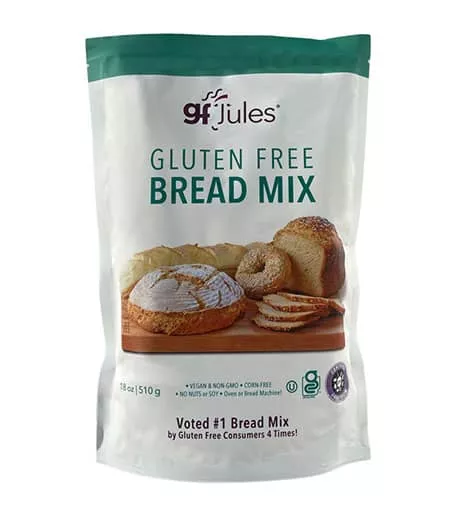

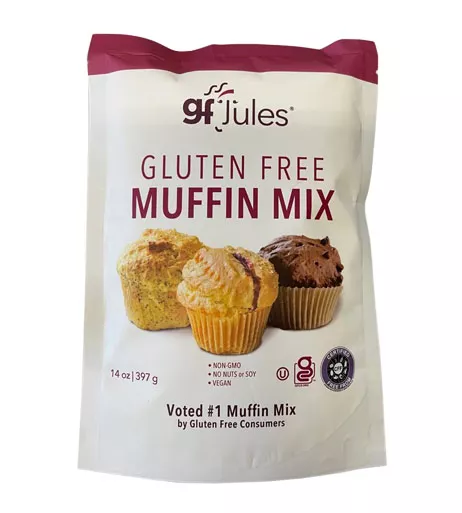


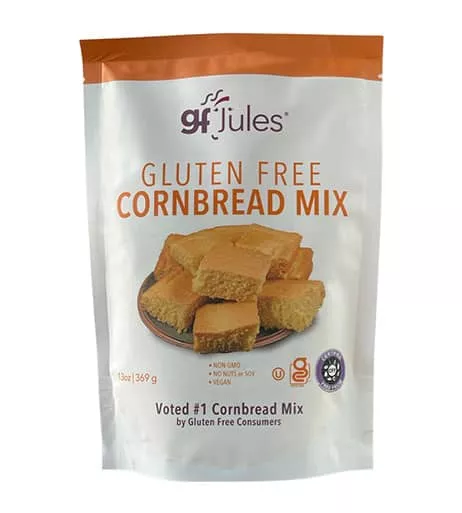



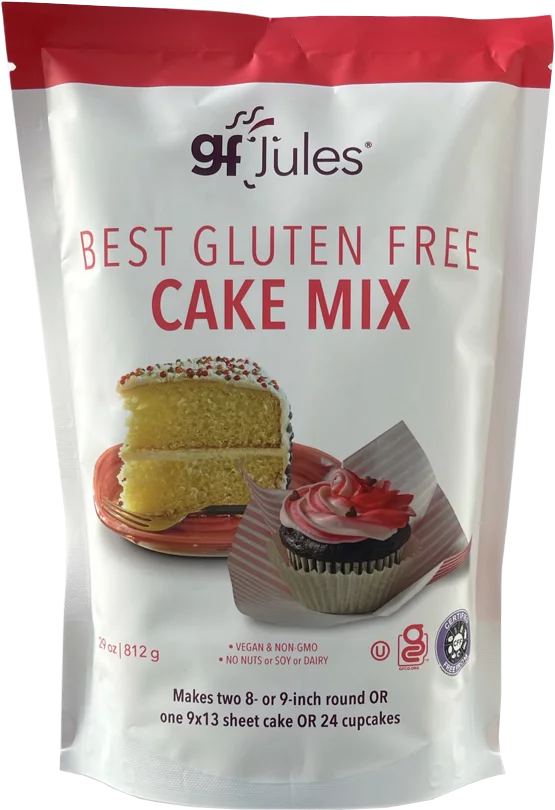
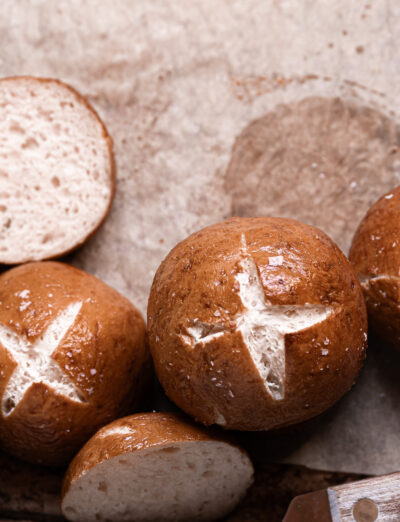

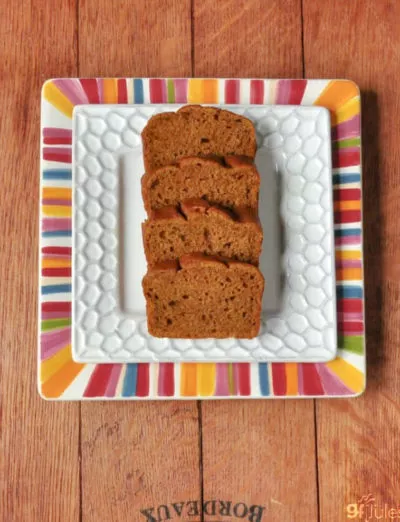








I’ve just discovered your site and the sourdough looks wonderful. I live in N Wales, Great Britain and used to love normal sourdough till I developed IBS. I can’t see where it say how to make the starter ? Have I missed a page perhaps? This is a. Great way to keep busy now we’ve all been told to self isolate to limit the Corona. Iris spread, especially us who are a little older . Your site is very clearly laid out and the photos are mouthwatering. All the online stores here that sell GF are shut now because of demand overload so it’s always helpful to have new ways of making a GF flour blend with fours I’ve got in my freezer or flour bin. Thank you for sharing.
Hello Augustine, it’s nice to meet you (virtually)! I hope you hang in there and stay well! Making sourdough is a wonderful way to pass some of the time you’re finding yourself with due to the Corona virus, for sure. If you read up in the paragraphs above the recipe card, you’ll find the directions for making the starter. It’s quite easy! I hope you enjoy the process of making gluten free sourdough. You might also enjoy my gluten free pumpernickel bread recipe, as well! Here’s more information on gluten-free flours for you, too.
Happy baking!
~jules
I don’t have powdered milk but have evaporated. With all the baking foods on short supply am I able to use this as a substitute ?
Also, no pysillium husk? Ok or any recommended substitutions?
Thank you!
Loads of thanks and appreciation for your hard work to achieve this.
However, am intolerant to starch, gluten and gums hence how can we make this sourdough starter with buckwheat flour. Ps guide. Thanks
I don’t know about the starch in the gum but buckwheat flour is gluten-free.
I am doing this for the first time and it was bubbly and appeared ready on the 3rd day. Wow! Is that possible?
Hi Hellen, I am by no means a sourdough expert — I have laid out the extent of my sourdough expertise in this article — but I experienced the same thing myself! I had days where it was bubbly and quite alive, and then several days later it appeared to have gone dormant. I was able to “wake” it back up though, by adding more “food” and then sometimes I needed to add more apple cider vinegar. It was quite the science experiment, but it was very fun! I hope you enjoy!
~jules
I wanted to read this article… I tried and tried, forcing myself to keep trying…but alas, I have finally admitted defeat. The preponderance of advertising on the article has rendered it nearly impossible to do so and has reduced my screen space down to about a quarter of the full screen… and because I have to scroll so much, it’s causing me pain in my thumbs from trying to scroll on my tablet. I will no longer view websites that force so much advertising on me that I can’t read the denned article without having to ice my thumbs when I’m done! And honestly, it isn’t just your page, but today I have decided to immediately back out of interesting articles that require too much effort to read…it isn’t worth it to me any more. 😥
Hi Kim, I’m sorry your experience was so difficult. I hear you and agree that the ads are everywhere anymore, and can tend to be overwhelming, especially in an article as long as this one. Unfortunately, it’s a bit of a necessary evil to support the creation of the content, which allows readers to have access to the recipes and articles free of charge. It takes so much time and effort for me to put together recipes, videos and photos, and I want to be able to continue to share them for free, which is where the ads come in, to help me fund the blog and keep creating content. If you don’t want to see ads on my site or others, you can install an ad blocker that accommodates your preferences. I hope that helps!
~jules
Am i missing something , Where do the directions say to add the spring water? I’m assuming it goes in with the starter and egg mixture?
Thanks
Hi Christine, the spring water or filtered water goes with making the starter itself. When you’re making the gluten free sourdough loaf, you’ll be adding sparkling water or a bubbly liquid of some kind. I hope that clarifies it!
~jules
So the 1 1/4 cups of sparkling water goes into the mixture with the eggs?
I often add the liquids towards the end of bread recipes so that it goes on top of the gluten free flour to keep it from flying all over the place 🙂 but yes, it goes with the liquids. Enjoy!
~jules
Hi, I’m a little confused… after making the starter, I have to feed it 2 cups of the gf flour a day for 7 days? That’s a lot of flour and a lot of starter…
Hi Michelle, that’s how chef Patrick recommended doing it, but it does make A LOT of starter! I haven’t tried it myself yet, which is why I haven’t recommended it as an option, but I don’t see why you couldn’t use half the amount of flour and water each time; I think it’s more about the ratio being correct than the total amounts. That’s what I was planning to do next time I made starter (but I still have so much! LOL!)
~jules
I’ve been successful making a starter with about half a cup the first day and then about two heaping spoonfuls for the feedings. The important thing to remember is the consistency should be pancake batter after mixing it all together.
Hey Jane
Did you remove some of the starter at each feed?
It’s all so confusing starting out 😂
Thanks
Bron
Definitely remove some of the starter at each feed … and YES it’s very confusing for all of us the first time around! If you’re on FB, please join the gfJules Gluten Free Recipe Share Group — there are tons of us on there sharing pictures, questions and answers about baking gluten free sourdough!
~jules
Have to say the don’t even bother with any flour but the proprietary blend I’m hawking is very off putting. Baking is about sharing and love and effort and time, not about chastising people for not purchasing the products you sell.
Hi Edward, I include that information because I always have people ask if they can use another blend. If you’ve done much gluten free baking, you surely know that all gluten free flour blends are very different. If I wrote a recipe, sharing it freely with people, as well as my love, effort and time, but then folks made it with a different blend and it didn’t work, I hope you can see that people would be a bit angry with me for wasting their time and effort.
I’m not “hawking” anything. I freely share my expertise, advocacy, recipes and advice on my website where you accessed this recipe. Because there isn’t another product on the market that works like mine does, people asked me years ago to start mixing it and offering it so that their gluten free baking could be reliably successful and delicious. I view that as a service, and I think my customers do too. Have a look at the hundreds of reviews on my site and see for yourself that my products have made a real difference in peoples’ lives, and for that, I feel truly blessed that I have been in a position to be able to help.
If you choose to try my recipes with a different blend, that’s of course up to you and I wish you every success. But please do not come back here and tell me that the recipe failed or doesn’t appear as pictured. That disappointment is what I try to avoid by telling people up front that my recipes were developed with my gfJules Flour blend.
~jules
Jules, I love your giving heart, and I am very grateful for your recipes. Thank you so much for sharing!💜
Oh Judy, that is so sweet of you to say. I am happy to be in a position to be able to share what I have learned. Thank you for your kind words! So glad you are enjoying my recipes!
~jules
Could you provide a link to the “Filtered water” you use in the recipe?
Hi Lisa, any kind of spring water, filtered water or water from a filter in your refrigerator will work. If you don’t have those, just use regular tap water.
~jules
FINALLY got around to getting my starter going! Question…when do I start halving it when feeding? Do I do it immediately and then each time or do I wait for it to be fully active? This is where I’ve often gotten lost before…I can’t wait for some good sourdough bread again!!!
LOL Sarah, I know – it gets complicated! What I did was to keep adding and not halving until I ran out of space in my bowl, then I halved (but couldn’t part with it, so I kept it going too!) and then every time I knew I was going to use it (after it was fed and active during that week), I would add more the night before then use the starter then add more and then refrigerate. It gets rather voluminous if you don’t halve it, but I can’t part with any gluten free anything, so I have a few containers of starter in my fridge now and I’ve given a few away! As long as it is growing and smelly, it should be active.
Can’t wait to hear how you like the sourdough!
~jules
Thanks so much! I was worried I was doing it wrong for feeding and such! Yeah. I’ve got it in my largest pot, but it’s gonna outgrow it quickly at this rate. Starting to see the bubbly and it’s just starting to smell like it should. Super excited! Guess I better get some bread mix ordered and more flour. Lol.
Sounds like you’re on the sourdough train!!! ENJOY!!!
~jules
This looks so good! A couple of questions…I’ve never made sourdough, but can see myself being overrun with starter. How long does it last in the fridge between bakings? Its just 2 in our house, so it takes time to get through a loaf of bread. Also once the starter is established, it just needs to be fed once a week? It seems like it takes an awful lot of flour to get it started and GF flour is so expensive. Is it possible to make a smaller amount so it doesn’t grow to such a large quantity?
Great questions Kathy! I have only made it the way it’s written: 1 cup gfJules Flour + 1 cup water. I don’t know why it wouldn’t work if you halved it and kept the proportions the same though. And yes, after it’s “active,” you just need to feed it 1/week, but TBH I have gone longer than 7 days and it’s still worked, so …! Try it with the halved amounts and see if it gets active with the same amount of yeast to start and apple cider vinegar if need be. There just needs to be enough flour to feed the starter, so you can always add more if it’s not looking like it’s working. I hope that helps!
~jules
Turned out great (the third time). Here’s some things to watch out for:
After I put the dough into the bread pan, I was too aggressive with the spatula and compacted the dough all the way down into the corners of the pan. As a result, it didn’t rise very much.
One time I added the soda water too soon and stirred out all of the bubbles. Didn’t read the recipe carefully enough.
I used buckwheat flour all three times. Flavor is good but it gives the bread a little grayish tint. I purchased some cassava flour for the next loaf.
My sourdough starter was definitely smelling more “sour” for the third loaf. It has to be consistently fed and given time to ferment.
Everyone in my family loves this bread. Even the non-celiac folks. Can’t wait to make it again! Thanks Jules!!
So happy you stuck with it, Tim! And thanks so much for taking the time to add your notes to the comments. I’m sure it’ll help others as they embark upon this gluten free sourdough journey!
~jules
So excited about this! Thanks for you and Chef working sourdough out for us. I have baked sourdough for 20 years or so but now need to be glutenfree. This is awesome….sourdough again. Thanks!
Wonderful to hear, Lynn! I’m so happy you’re going to be back in the sourdough soon!!!
~jules
I cannot wait to make this! I have your bread mix and also your flour. The only part I am confused on is how much starter to add to the recipe. I might have missed that part but I was trying to find a measurement. I am a complete novice at sourdough bread making! Thanks so much for providing this recipe to all of us. 🙂
I’m excited you’re excited, Michelle! If you read the recipe closely (admittedly, it’s long!), you’ll see that you need to add 3/4 cup of the starter for each loaf. Hope that helps!
~jules
Hi, thank you for sharing this recipe. I have a question, ome of your methods for allowing the dough to rise is puttin it in the preheated turned off oven and: “…after 3 hours, remove to refrigerator for overnight rise. Is it ok to do the overnight rise in the fridge if I use the eggs? I am unsure as you state somewhere in the main text that this would be if baking without any eggs. Appreciate your help. Thank you.
Hi Martin, yes the overnight rise in the fridge would be best if eggs are being used. Enjoy the recipe!
~jules
Hi Jules!! I am ready to try making bread! One question, do I still use the yeast packet if using the bread mix?
Hi Kim, for true sourdough, you would not use the yeast packet that comes with my breadmix, no. Once the starter is made, you shouldn’t need it. You can keep it for other recipes, though! Happy bread baking!
~jules
Awesome! I have been searching for a recipe for this bread for many months – details are adequate,more than adequete, for a beginner.thank you so much.will let you know how I progress ( can’t start for two weeks)
I’m so glad this recipe is just what you were looking for! Enjoy, Barbara!
~jules
Oh my gosh. I haven’t had sourdough in years and this looks like the real thing! Yum.
It IS! The texture is really amazing!
~jules
LOVE sourdough and need to start a gluten free starter and play around. I had planned to years ago when we first started our sourdough but as the days when on and my gluten free sensitive tummy (diagnose change from Celiac to sensitivity almost 10 years ago after an incorrect diagnoses years before) handled regular sourdough so well I never made one.
Thank you for sharing and cannot wait to start playing.
I can’t wait to hear how you like it, as as a true Sourdough Lover!
~jules
I already have a GF sourdough starter (was purchased)… do you think that would work instead of making my own?
OH wow – lucky you! I’ve never seen gluten free starter available for purchase! You should absolutely try it! (and come back and let me know how it goes, of course!) 🙂
Happy bread baking!
~jules
I am so excited to make this!!! Can I use your original recipe flour mix that I make at home? Thanks, Erin Hoover
Hi Erin, I imagine it will work, but having not tried it for this recipe I can’t say for certain. My gfJules Flour blend is quite different from the homemade recipe, so there will be differences, but fingers crossed it works! If not, you know you can always just use the pre-mixed blend and know it will work!
Happy baking!
~jules